MKT744 Global Marketing And Sales Development
VerifiedAdded on 2021/08/30
|42
|7370
|1422
AI Summary
Contribute Materials
Your contribution can guide someone’s learning journey. Share your
documents today.

GLOBAL MARKETING AND SALES DEVELOPMENT
MKT744 (92125)
August 29, 2021
B00790553
Lathi Loshi
MKT744 (92125)
August 29, 2021
B00790553
Lathi Loshi
Secure Best Marks with AI Grader
Need help grading? Try our AI Grader for instant feedback on your assignments.
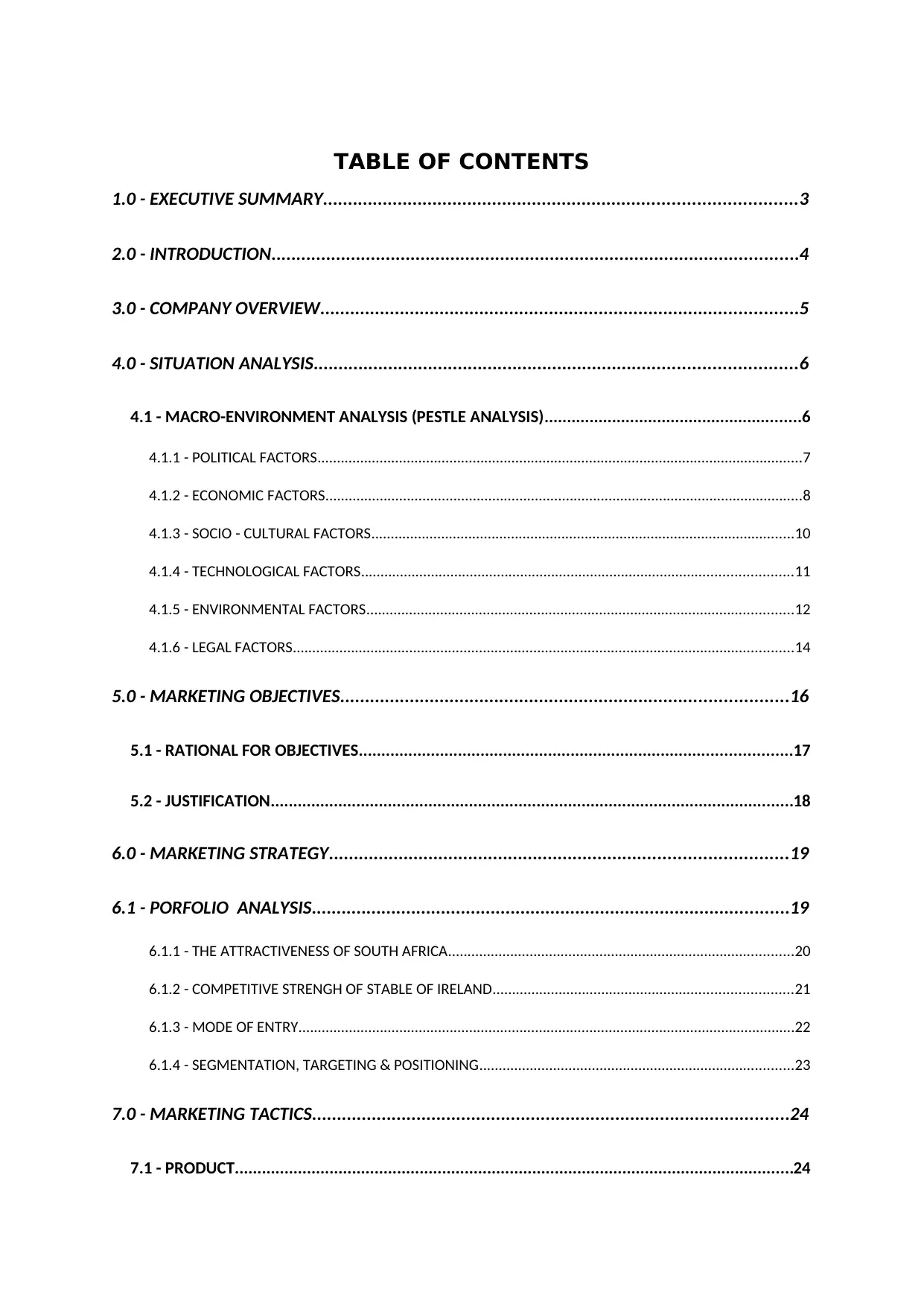
TABLE OF CONTENTS
1.0 - EXECUTIVE SUMMARY...............................................................................................3
2.0 - INTRODUCTION..........................................................................................................4
3.0 - COMPANY OVERVIEW................................................................................................5
4.0 - SITUATION ANALYSIS.................................................................................................6
4.1 - MACRO-ENVIRONMENT ANALYSIS (PESTLE ANALYSIS).........................................................6
4.1.1 - POLITICAL FACTORS.............................................................................................................................7
4.1.2 - ECONOMIC FACTORS...........................................................................................................................8
4.1.3 - SOCIO - CULTURAL FACTORS.............................................................................................................10
4.1.4 - TECHNOLOGICAL FACTORS...............................................................................................................11
4.1.5 - ENVIRONMENTAL FACTORS..............................................................................................................12
4.1.6 - LEGAL FACTORS.................................................................................................................................14
5.0 - MARKETING OBJECTIVES..........................................................................................16
5.1 - RATIONAL FOR OBJECTIVES................................................................................................17
5.2 - JUSTIFICATION....................................................................................................................18
6.0 - MARKETING STRATEGY............................................................................................19
6.1 - PORFOLIO ANALYSIS................................................................................................19
6.1.1 - THE ATTRACTIVENESS OF SOUTH AFRICA.........................................................................................20
6.1.2 - COMPETITIVE STRENGH OF STABLE OF IRELAND.............................................................................21
6.1.3 - MODE OF ENTRY................................................................................................................................22
6.1.4 - SEGMENTATION, TARGETING & POSITIONING.................................................................................23
7.0 - MARKETING TACTICS................................................................................................24
7.1 - PRODUCT............................................................................................................................24
1.0 - EXECUTIVE SUMMARY...............................................................................................3
2.0 - INTRODUCTION..........................................................................................................4
3.0 - COMPANY OVERVIEW................................................................................................5
4.0 - SITUATION ANALYSIS.................................................................................................6
4.1 - MACRO-ENVIRONMENT ANALYSIS (PESTLE ANALYSIS).........................................................6
4.1.1 - POLITICAL FACTORS.............................................................................................................................7
4.1.2 - ECONOMIC FACTORS...........................................................................................................................8
4.1.3 - SOCIO - CULTURAL FACTORS.............................................................................................................10
4.1.4 - TECHNOLOGICAL FACTORS...............................................................................................................11
4.1.5 - ENVIRONMENTAL FACTORS..............................................................................................................12
4.1.6 - LEGAL FACTORS.................................................................................................................................14
5.0 - MARKETING OBJECTIVES..........................................................................................16
5.1 - RATIONAL FOR OBJECTIVES................................................................................................17
5.2 - JUSTIFICATION....................................................................................................................18
6.0 - MARKETING STRATEGY............................................................................................19
6.1 - PORFOLIO ANALYSIS................................................................................................19
6.1.1 - THE ATTRACTIVENESS OF SOUTH AFRICA.........................................................................................20
6.1.2 - COMPETITIVE STRENGH OF STABLE OF IRELAND.............................................................................21
6.1.3 - MODE OF ENTRY................................................................................................................................22
6.1.4 - SEGMENTATION, TARGETING & POSITIONING.................................................................................23
7.0 - MARKETING TACTICS................................................................................................24
7.1 - PRODUCT............................................................................................................................24

7.2 - PRICE..................................................................................................................................25
7.3 - PLACE.................................................................................................................................26
7.4 - PROMOTION.......................................................................................................................27
8.0 - MARKETING ACTION PLAN.......................................................................................28
9.0 - CONCLUSION............................................................................................................29
10.0 - BIBLIOGRAPHY.......................................................................................................30
11.0 - APPENDIX 1 - MCKINSEY’S 7 S MODEL....................................................................37
11.1 - SHARED VALUES.................................................................................................................................37
11.2 - STRATEGY...........................................................................................................................................37
11.3 - STRUCTURE.........................................................................................................................................38
11.4 - SYSTEMS.............................................................................................................................................38
11.5 - STYLE...................................................................................................................................................38
11.6 - STAFF..................................................................................................................................................39
11.7 - SKILLS..................................................................................................................................................39
12.0 - APPENDIX 2 - PORTERS FIVE FORCES.......................................................................40
7.3 - PLACE.................................................................................................................................26
7.4 - PROMOTION.......................................................................................................................27
8.0 - MARKETING ACTION PLAN.......................................................................................28
9.0 - CONCLUSION............................................................................................................29
10.0 - BIBLIOGRAPHY.......................................................................................................30
11.0 - APPENDIX 1 - MCKINSEY’S 7 S MODEL....................................................................37
11.1 - SHARED VALUES.................................................................................................................................37
11.2 - STRATEGY...........................................................................................................................................37
11.3 - STRUCTURE.........................................................................................................................................38
11.4 - SYSTEMS.............................................................................................................................................38
11.5 - STYLE...................................................................................................................................................38
11.6 - STAFF..................................................................................................................................................39
11.7 - SKILLS..................................................................................................................................................39
12.0 - APPENDIX 2 - PORTERS FIVE FORCES.......................................................................40

1.0 - EXECUTIVE SUMMARY
This report will evaluate the globalisation of Stable of Ireland into South Africa.
Founded in 2015, Stable of Ireland crafts handmade luxury ready-to-wear and home
textiles. As an SME, the short term objectives of Stable are to sustain online and
retail sales, with the long term objective to expand internationally; South Africa being
a prime location due to its economically steady and technologically advanced status.
A thorough PESTLE analysis has been conducted, covering political, economic,
socio-cultural, technological, environmental and legal factors that would effect the
internationalisation strategy. The evaluation demonstrates greater prospects than
risk, with the South African textile industry value expected to rise 6 billion in 7 years.
Careful consideration has been given to the methods employed to execute Stable of
Ireland’s business plan, namely market penetration and exporting. Porters Five
Forces and Mckinsey’s 7 S model have also been used as a means of analysis in
this report to further explore the competitive environment amongst other factors.
This report will evaluate the globalisation of Stable of Ireland into South Africa.
Founded in 2015, Stable of Ireland crafts handmade luxury ready-to-wear and home
textiles. As an SME, the short term objectives of Stable are to sustain online and
retail sales, with the long term objective to expand internationally; South Africa being
a prime location due to its economically steady and technologically advanced status.
A thorough PESTLE analysis has been conducted, covering political, economic,
socio-cultural, technological, environmental and legal factors that would effect the
internationalisation strategy. The evaluation demonstrates greater prospects than
risk, with the South African textile industry value expected to rise 6 billion in 7 years.
Careful consideration has been given to the methods employed to execute Stable of
Ireland’s business plan, namely market penetration and exporting. Porters Five
Forces and Mckinsey’s 7 S model have also been used as a means of analysis in
this report to further explore the competitive environment amongst other factors.
Secure Best Marks with AI Grader
Need help grading? Try our AI Grader for instant feedback on your assignments.
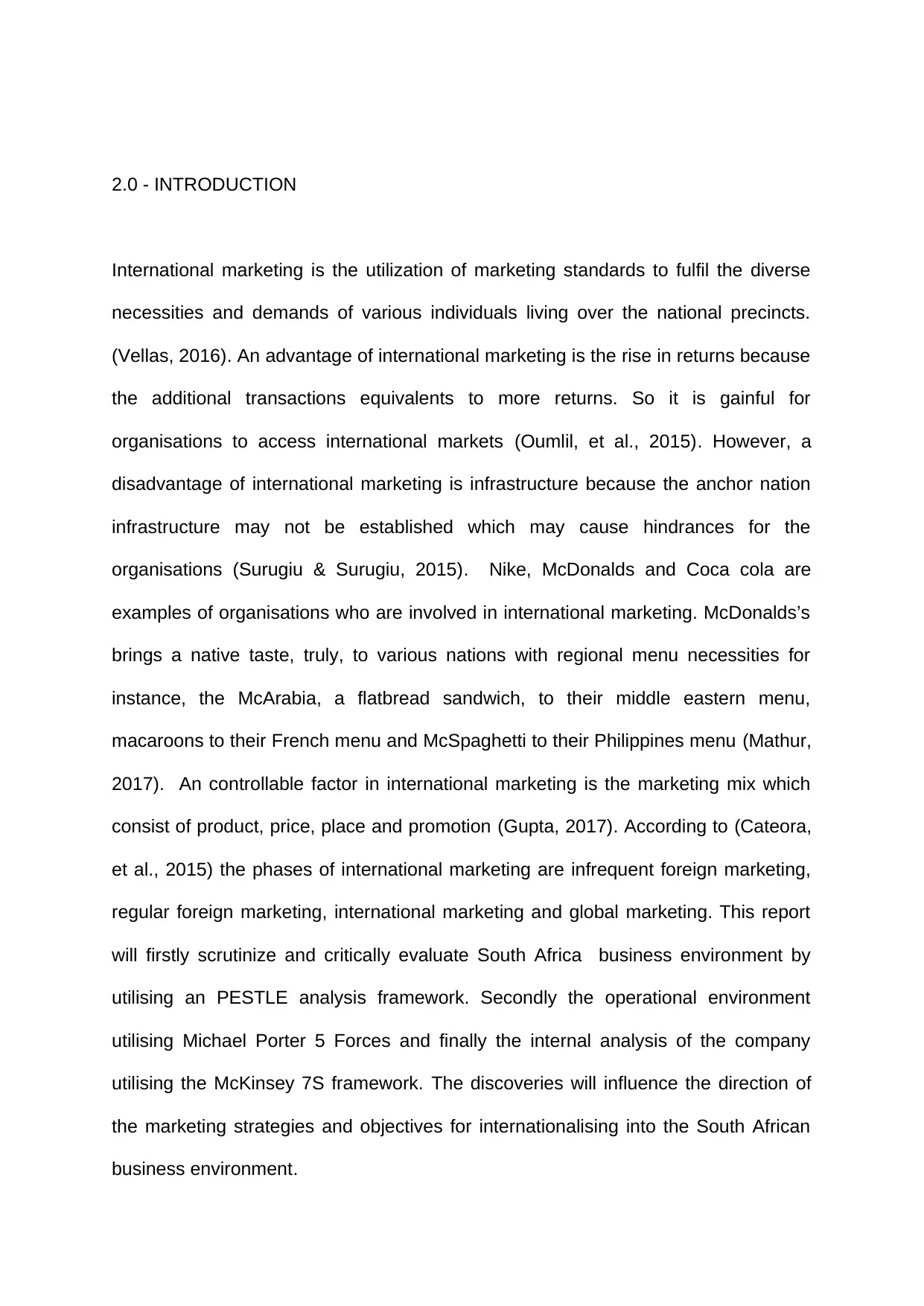
2.0 - INTRODUCTION
International marketing is the utilization of marketing standards to fulfil the diverse
necessities and demands of various individuals living over the national precincts.
(Vellas, 2016). An advantage of international marketing is the rise in returns because
the additional transactions equivalents to more returns. So it is gainful for
organisations to access international markets (Oumlil, et al., 2015). However, a
disadvantage of international marketing is infrastructure because the anchor nation
infrastructure may not be established which may cause hindrances for the
organisations (Surugiu & Surugiu, 2015). Nike, McDonalds and Coca cola are
examples of organisations who are involved in international marketing. McDonalds’s
brings a native taste, truly, to various nations with regional menu necessities for
instance, the McArabia, a flatbread sandwich, to their middle eastern menu,
macaroons to their French menu and McSpaghetti to their Philippines menu (Mathur,
2017). An controllable factor in international marketing is the marketing mix which
consist of product, price, place and promotion (Gupta, 2017). According to (Cateora,
et al., 2015) the phases of international marketing are infrequent foreign marketing,
regular foreign marketing, international marketing and global marketing. This report
will firstly scrutinize and critically evaluate South Africa business environment by
utilising an PESTLE analysis framework. Secondly the operational environment
utilising Michael Porter 5 Forces and finally the internal analysis of the company
utilising the McKinsey 7S framework. The discoveries will influence the direction of
the marketing strategies and objectives for internationalising into the South African
business environment.
International marketing is the utilization of marketing standards to fulfil the diverse
necessities and demands of various individuals living over the national precincts.
(Vellas, 2016). An advantage of international marketing is the rise in returns because
the additional transactions equivalents to more returns. So it is gainful for
organisations to access international markets (Oumlil, et al., 2015). However, a
disadvantage of international marketing is infrastructure because the anchor nation
infrastructure may not be established which may cause hindrances for the
organisations (Surugiu & Surugiu, 2015). Nike, McDonalds and Coca cola are
examples of organisations who are involved in international marketing. McDonalds’s
brings a native taste, truly, to various nations with regional menu necessities for
instance, the McArabia, a flatbread sandwich, to their middle eastern menu,
macaroons to their French menu and McSpaghetti to their Philippines menu (Mathur,
2017). An controllable factor in international marketing is the marketing mix which
consist of product, price, place and promotion (Gupta, 2017). According to (Cateora,
et al., 2015) the phases of international marketing are infrequent foreign marketing,
regular foreign marketing, international marketing and global marketing. This report
will firstly scrutinize and critically evaluate South Africa business environment by
utilising an PESTLE analysis framework. Secondly the operational environment
utilising Michael Porter 5 Forces and finally the internal analysis of the company
utilising the McKinsey 7S framework. The discoveries will influence the direction of
the marketing strategies and objectives for internationalising into the South African
business environment.
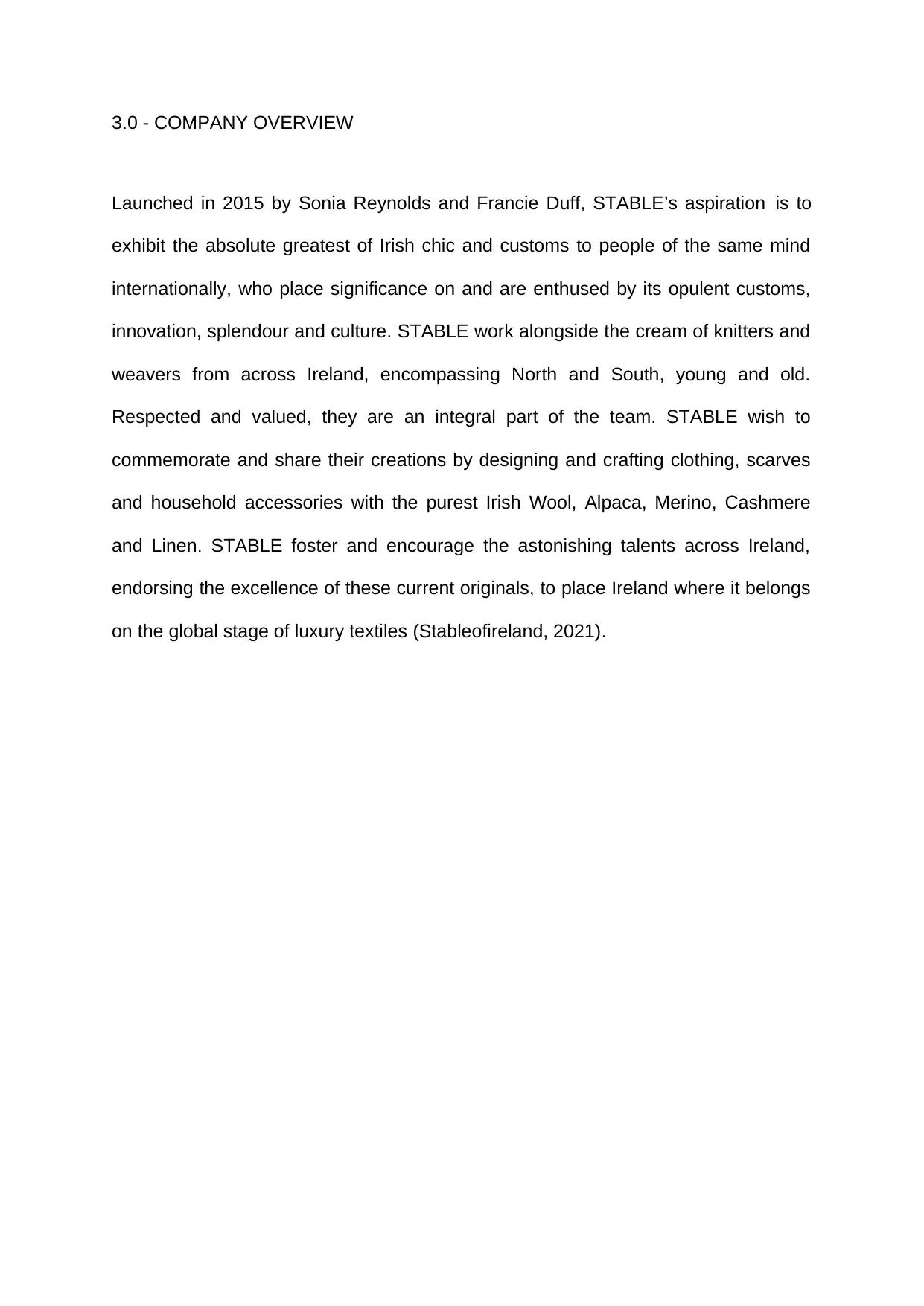
3.0 - COMPANY OVERVIEW
Launched in 2015 by Sonia Reynolds and Francie Duff, STABLE’s aspiration is to
exhibit the absolute greatest of Irish chic and customs to people of the same mind
internationally, who place significance on and are enthused by its opulent customs,
innovation, splendour and culture. STABLE work alongside the cream of knitters and
weavers from across Ireland, encompassing North and South, young and old.
Respected and valued, they are an integral part of the team. STABLE wish to
commemorate and share their creations by designing and crafting clothing, scarves
and household accessories with the purest Irish Wool, Alpaca, Merino, Cashmere
and Linen. STABLE foster and encourage the astonishing talents across Ireland,
endorsing the excellence of these current originals, to place Ireland where it belongs
on the global stage of luxury textiles (Stableofireland, 2021).
Launched in 2015 by Sonia Reynolds and Francie Duff, STABLE’s aspiration is to
exhibit the absolute greatest of Irish chic and customs to people of the same mind
internationally, who place significance on and are enthused by its opulent customs,
innovation, splendour and culture. STABLE work alongside the cream of knitters and
weavers from across Ireland, encompassing North and South, young and old.
Respected and valued, they are an integral part of the team. STABLE wish to
commemorate and share their creations by designing and crafting clothing, scarves
and household accessories with the purest Irish Wool, Alpaca, Merino, Cashmere
and Linen. STABLE foster and encourage the astonishing talents across Ireland,
endorsing the excellence of these current originals, to place Ireland where it belongs
on the global stage of luxury textiles (Stableofireland, 2021).
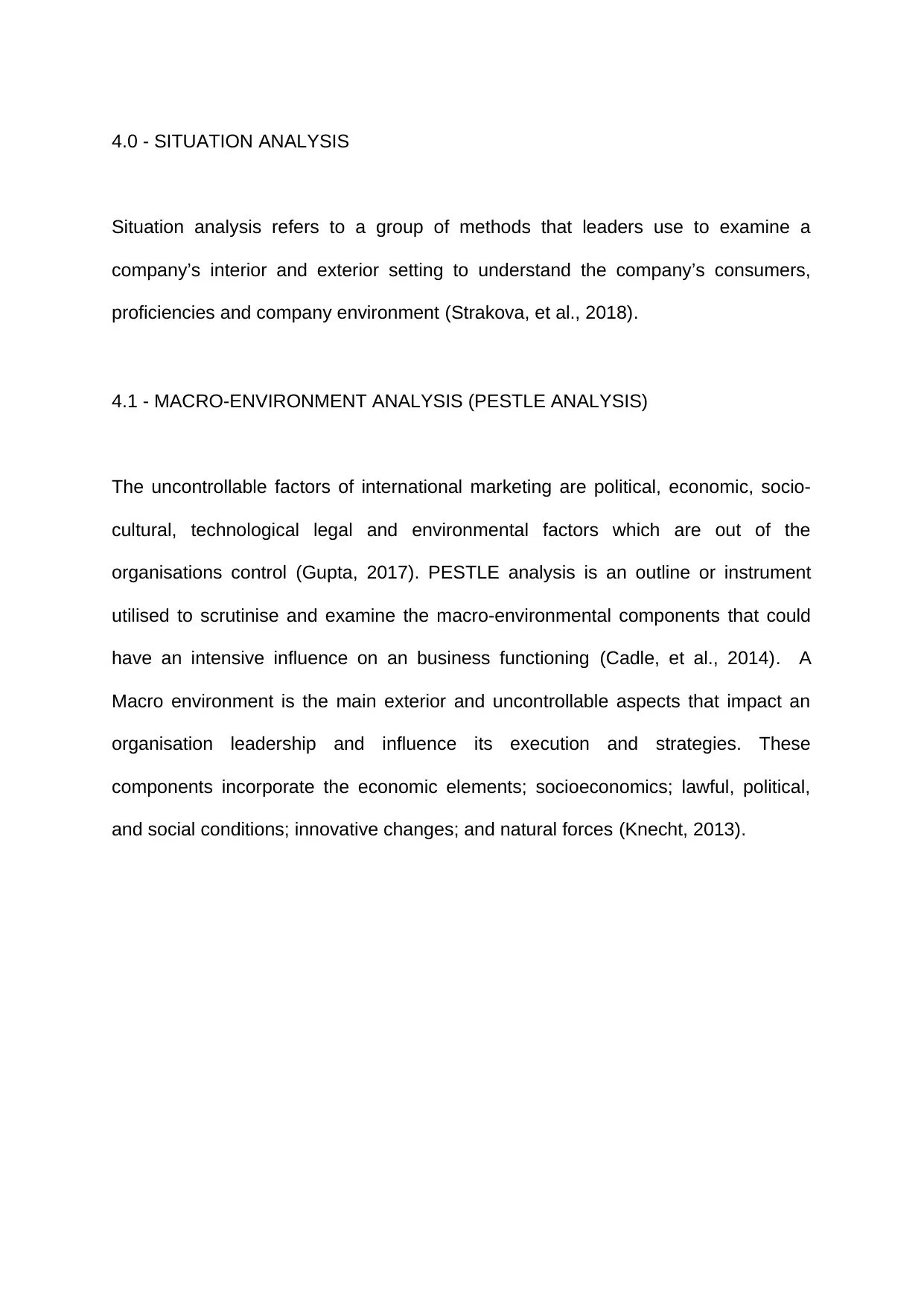
4.0 - SITUATION ANALYSIS
Situation analysis refers to a group of methods that leaders use to examine a
company’s interior and exterior setting to understand the company’s consumers,
proficiencies and company environment (Strakova, et al., 2018).
4.1 - MACRO-ENVIRONMENT ANALYSIS (PESTLE ANALYSIS)
The uncontrollable factors of international marketing are political, economic, socio-
cultural, technological legal and environmental factors which are out of the
organisations control (Gupta, 2017). PESTLE analysis is an outline or instrument
utilised to scrutinise and examine the macro-environmental components that could
have an intensive influence on an business functioning (Cadle, et al., 2014). A
Macro environment is the main exterior and uncontrollable aspects that impact an
organisation leadership and influence its execution and strategies. These
components incorporate the economic elements; socioeconomics; lawful, political,
and social conditions; innovative changes; and natural forces (Knecht, 2013).
Situation analysis refers to a group of methods that leaders use to examine a
company’s interior and exterior setting to understand the company’s consumers,
proficiencies and company environment (Strakova, et al., 2018).
4.1 - MACRO-ENVIRONMENT ANALYSIS (PESTLE ANALYSIS)
The uncontrollable factors of international marketing are political, economic, socio-
cultural, technological legal and environmental factors which are out of the
organisations control (Gupta, 2017). PESTLE analysis is an outline or instrument
utilised to scrutinise and examine the macro-environmental components that could
have an intensive influence on an business functioning (Cadle, et al., 2014). A
Macro environment is the main exterior and uncontrollable aspects that impact an
organisation leadership and influence its execution and strategies. These
components incorporate the economic elements; socioeconomics; lawful, political,
and social conditions; innovative changes; and natural forces (Knecht, 2013).
Paraphrase This Document
Need a fresh take? Get an instant paraphrase of this document with our AI Paraphraser
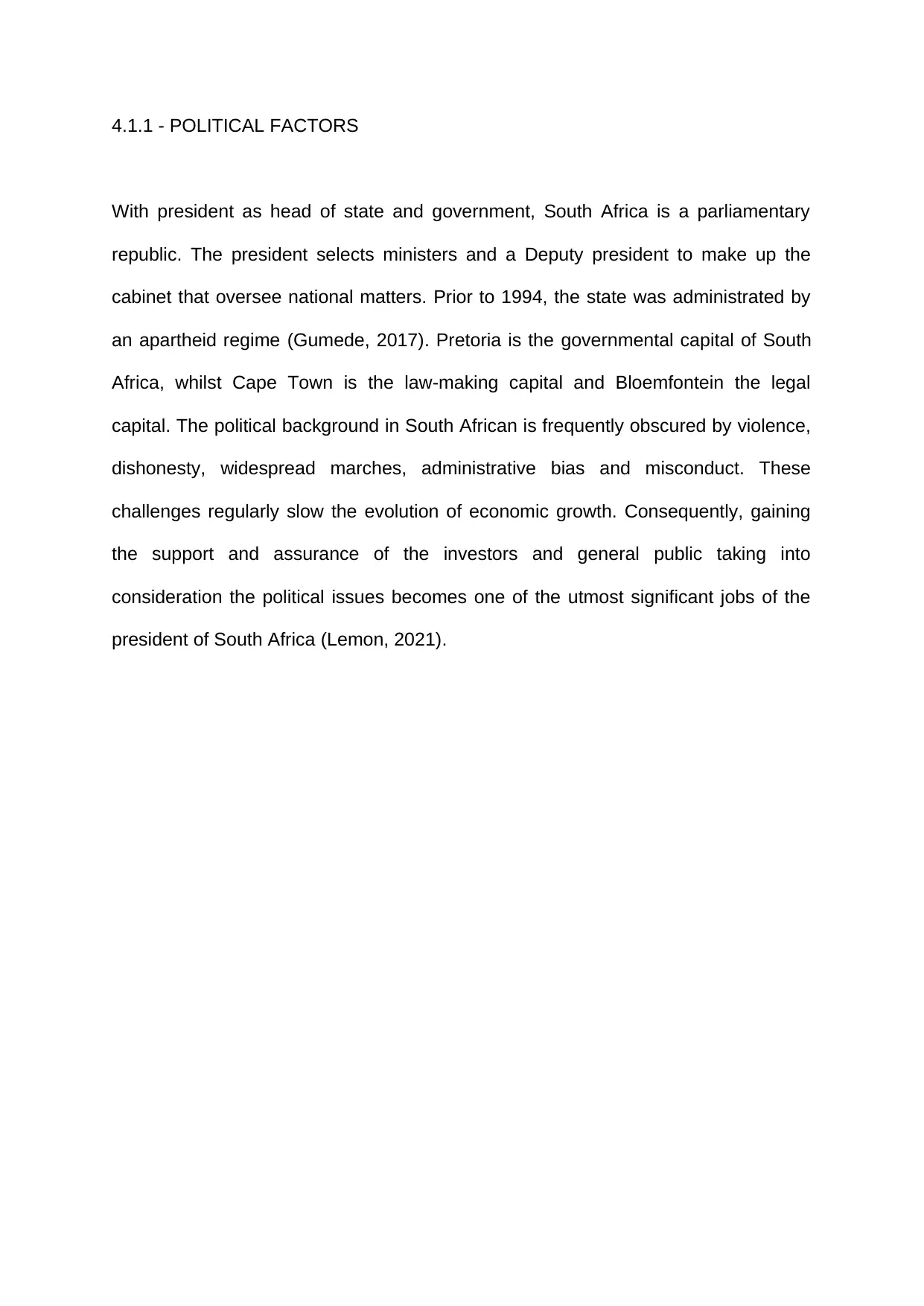
4.1.1 - POLITICAL FACTORS
With president as head of state and government, South Africa is a parliamentary
republic. The president selects ministers and a Deputy president to make up the
cabinet that oversee national matters. Prior to 1994, the state was administrated by
an apartheid regime (Gumede, 2017). Pretoria is the governmental capital of South
Africa, whilst Cape Town is the law-making capital and Bloemfontein the legal
capital. The political background in South African is frequently obscured by violence,
dishonesty, widespread marches, administrative bias and misconduct. These
challenges regularly slow the evolution of economic growth. Consequently, gaining
the support and assurance of the investors and general public taking into
consideration the political issues becomes one of the utmost significant jobs of the
president of South Africa (Lemon, 2021).
With president as head of state and government, South Africa is a parliamentary
republic. The president selects ministers and a Deputy president to make up the
cabinet that oversee national matters. Prior to 1994, the state was administrated by
an apartheid regime (Gumede, 2017). Pretoria is the governmental capital of South
Africa, whilst Cape Town is the law-making capital and Bloemfontein the legal
capital. The political background in South African is frequently obscured by violence,
dishonesty, widespread marches, administrative bias and misconduct. These
challenges regularly slow the evolution of economic growth. Consequently, gaining
the support and assurance of the investors and general public taking into
consideration the political issues becomes one of the utmost significant jobs of the
president of South Africa (Lemon, 2021).
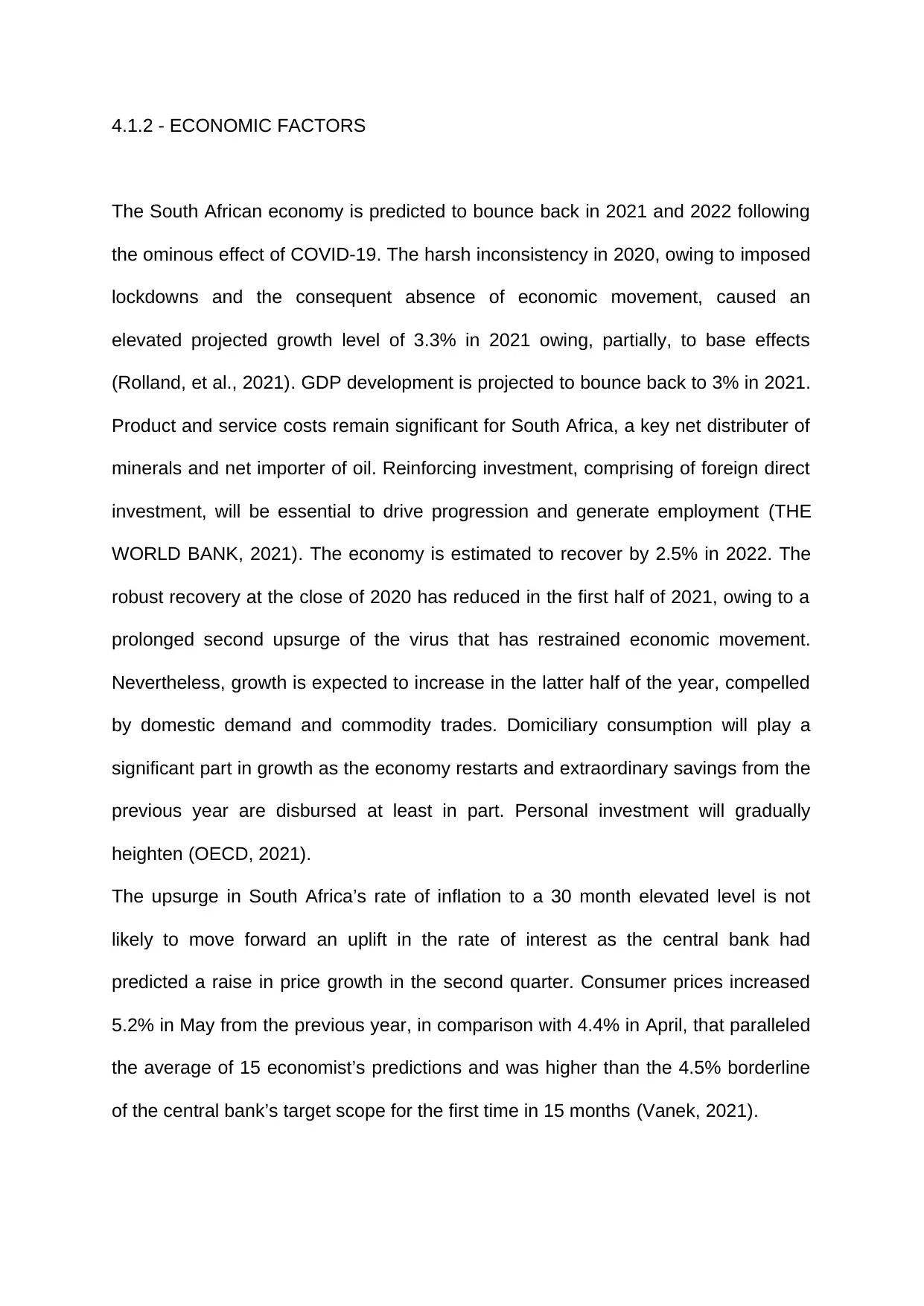
4.1.2 - ECONOMIC FACTORS
The South African economy is predicted to bounce back in 2021 and 2022 following
the ominous effect of COVID-19. The harsh inconsistency in 2020, owing to imposed
lockdowns and the consequent absence of economic movement, caused an
elevated projected growth level of 3.3% in 2021 owing, partially, to base effects
(Rolland, et al., 2021). GDP development is projected to bounce back to 3% in 2021.
Product and service costs remain significant for South Africa, a key net distributer of
minerals and net importer of oil. Reinforcing investment, comprising of foreign direct
investment, will be essential to drive progression and generate employment (THE
WORLD BANK, 2021). The economy is estimated to recover by 2.5% in 2022. The
robust recovery at the close of 2020 has reduced in the first half of 2021, owing to a
prolonged second upsurge of the virus that has restrained economic movement.
Nevertheless, growth is expected to increase in the latter half of the year, compelled
by domestic demand and commodity trades. Domiciliary consumption will play a
significant part in growth as the economy restarts and extraordinary savings from the
previous year are disbursed at least in part. Personal investment will gradually
heighten (OECD, 2021).
The upsurge in South Africa’s rate of inflation to a 30 month elevated level is not
likely to move forward an uplift in the rate of interest as the central bank had
predicted a raise in price growth in the second quarter. Consumer prices increased
5.2% in May from the previous year, in comparison with 4.4% in April, that paralleled
the average of 15 economist’s predictions and was higher than the 4.5% borderline
of the central bank’s target scope for the first time in 15 months (Vanek, 2021).
The South African economy is predicted to bounce back in 2021 and 2022 following
the ominous effect of COVID-19. The harsh inconsistency in 2020, owing to imposed
lockdowns and the consequent absence of economic movement, caused an
elevated projected growth level of 3.3% in 2021 owing, partially, to base effects
(Rolland, et al., 2021). GDP development is projected to bounce back to 3% in 2021.
Product and service costs remain significant for South Africa, a key net distributer of
minerals and net importer of oil. Reinforcing investment, comprising of foreign direct
investment, will be essential to drive progression and generate employment (THE
WORLD BANK, 2021). The economy is estimated to recover by 2.5% in 2022. The
robust recovery at the close of 2020 has reduced in the first half of 2021, owing to a
prolonged second upsurge of the virus that has restrained economic movement.
Nevertheless, growth is expected to increase in the latter half of the year, compelled
by domestic demand and commodity trades. Domiciliary consumption will play a
significant part in growth as the economy restarts and extraordinary savings from the
previous year are disbursed at least in part. Personal investment will gradually
heighten (OECD, 2021).
The upsurge in South Africa’s rate of inflation to a 30 month elevated level is not
likely to move forward an uplift in the rate of interest as the central bank had
predicted a raise in price growth in the second quarter. Consumer prices increased
5.2% in May from the previous year, in comparison with 4.4% in April, that paralleled
the average of 15 economist’s predictions and was higher than the 4.5% borderline
of the central bank’s target scope for the first time in 15 months (Vanek, 2021).
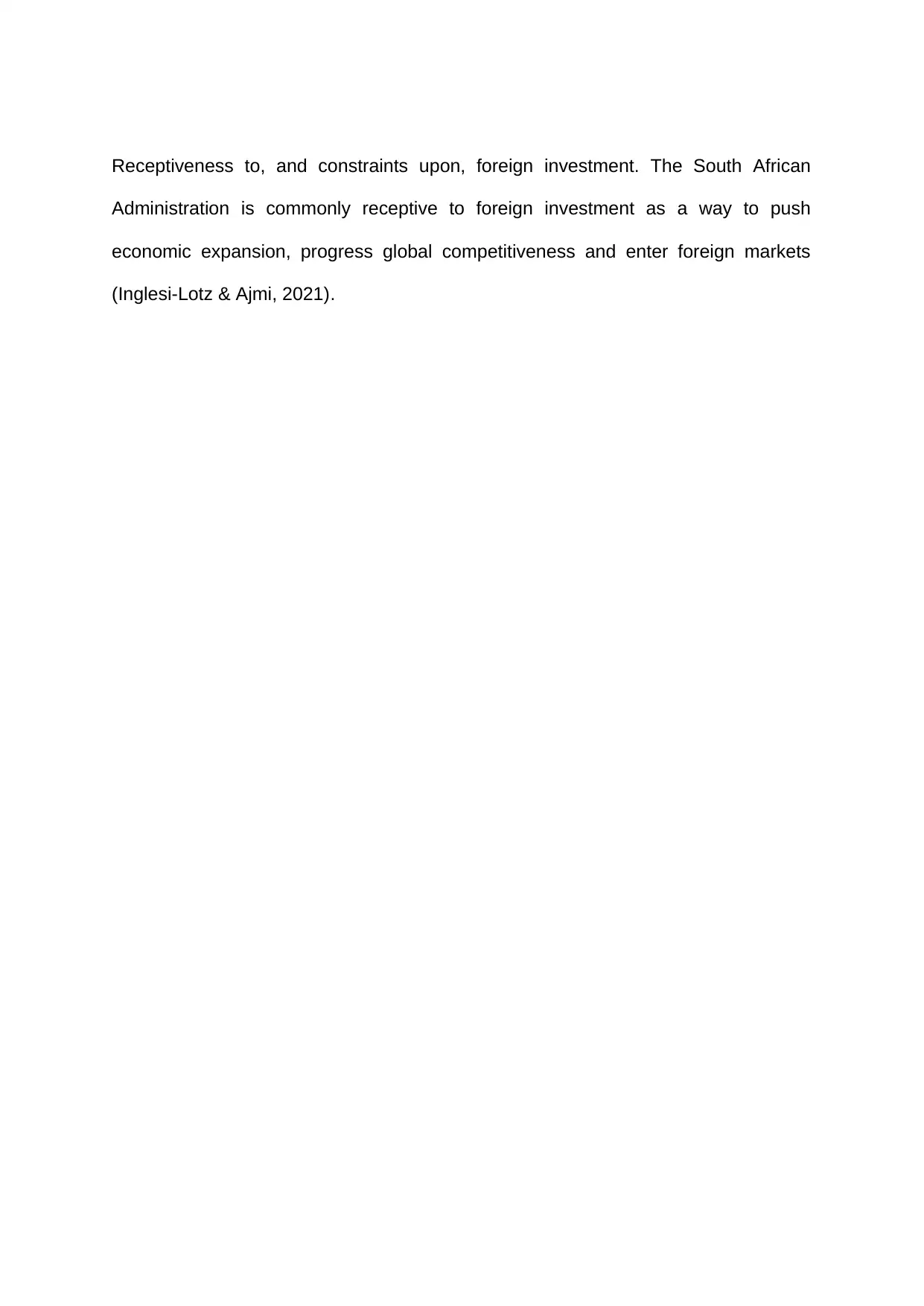
Receptiveness to, and constraints upon, foreign investment. The South African
Administration is commonly receptive to foreign investment as a way to push
economic expansion, progress global competitiveness and enter foreign markets
(Inglesi-Lotz & Ajmi, 2021).
Administration is commonly receptive to foreign investment as a way to push
economic expansion, progress global competitiveness and enter foreign markets
(Inglesi-Lotz & Ajmi, 2021).
Secure Best Marks with AI Grader
Need help grading? Try our AI Grader for instant feedback on your assignments.
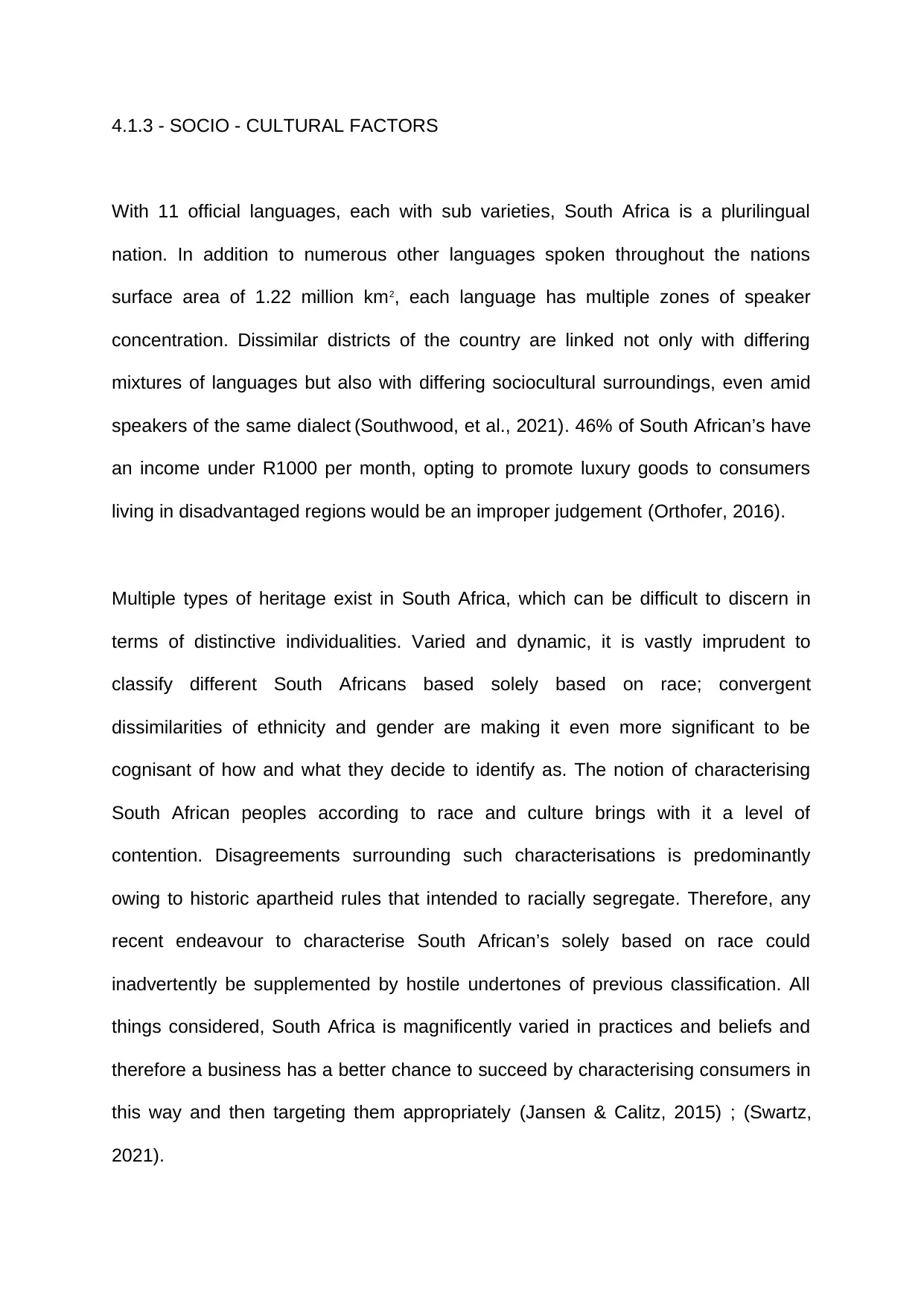
4.1.3 - SOCIO - CULTURAL FACTORS
With 11 official languages, each with sub varieties, South Africa is a plurilingual
nation. In addition to numerous other languages spoken throughout the nations
surface area of 1.22 million km2, each language has multiple zones of speaker
concentration. Dissimilar districts of the country are linked not only with differing
mixtures of languages but also with differing sociocultural surroundings, even amid
speakers of the same dialect (Southwood, et al., 2021). 46% of South African’s have
an income under R1000 per month, opting to promote luxury goods to consumers
living in disadvantaged regions would be an improper judgement (Orthofer, 2016).
Multiple types of heritage exist in South Africa, which can be difficult to discern in
terms of distinctive individualities. Varied and dynamic, it is vastly imprudent to
classify different South Africans based solely based on race; convergent
dissimilarities of ethnicity and gender are making it even more significant to be
cognisant of how and what they decide to identify as. The notion of characterising
South African peoples according to race and culture brings with it a level of
contention. Disagreements surrounding such characterisations is predominantly
owing to historic apartheid rules that intended to racially segregate. Therefore, any
recent endeavour to characterise South African’s solely based on race could
inadvertently be supplemented by hostile undertones of previous classification. All
things considered, South Africa is magnificently varied in practices and beliefs and
therefore a business has a better chance to succeed by characterising consumers in
this way and then targeting them appropriately (Jansen & Calitz, 2015) ; (Swartz,
2021).
With 11 official languages, each with sub varieties, South Africa is a plurilingual
nation. In addition to numerous other languages spoken throughout the nations
surface area of 1.22 million km2, each language has multiple zones of speaker
concentration. Dissimilar districts of the country are linked not only with differing
mixtures of languages but also with differing sociocultural surroundings, even amid
speakers of the same dialect (Southwood, et al., 2021). 46% of South African’s have
an income under R1000 per month, opting to promote luxury goods to consumers
living in disadvantaged regions would be an improper judgement (Orthofer, 2016).
Multiple types of heritage exist in South Africa, which can be difficult to discern in
terms of distinctive individualities. Varied and dynamic, it is vastly imprudent to
classify different South Africans based solely based on race; convergent
dissimilarities of ethnicity and gender are making it even more significant to be
cognisant of how and what they decide to identify as. The notion of characterising
South African peoples according to race and culture brings with it a level of
contention. Disagreements surrounding such characterisations is predominantly
owing to historic apartheid rules that intended to racially segregate. Therefore, any
recent endeavour to characterise South African’s solely based on race could
inadvertently be supplemented by hostile undertones of previous classification. All
things considered, South Africa is magnificently varied in practices and beliefs and
therefore a business has a better chance to succeed by characterising consumers in
this way and then targeting them appropriately (Jansen & Calitz, 2015) ; (Swartz,
2021).
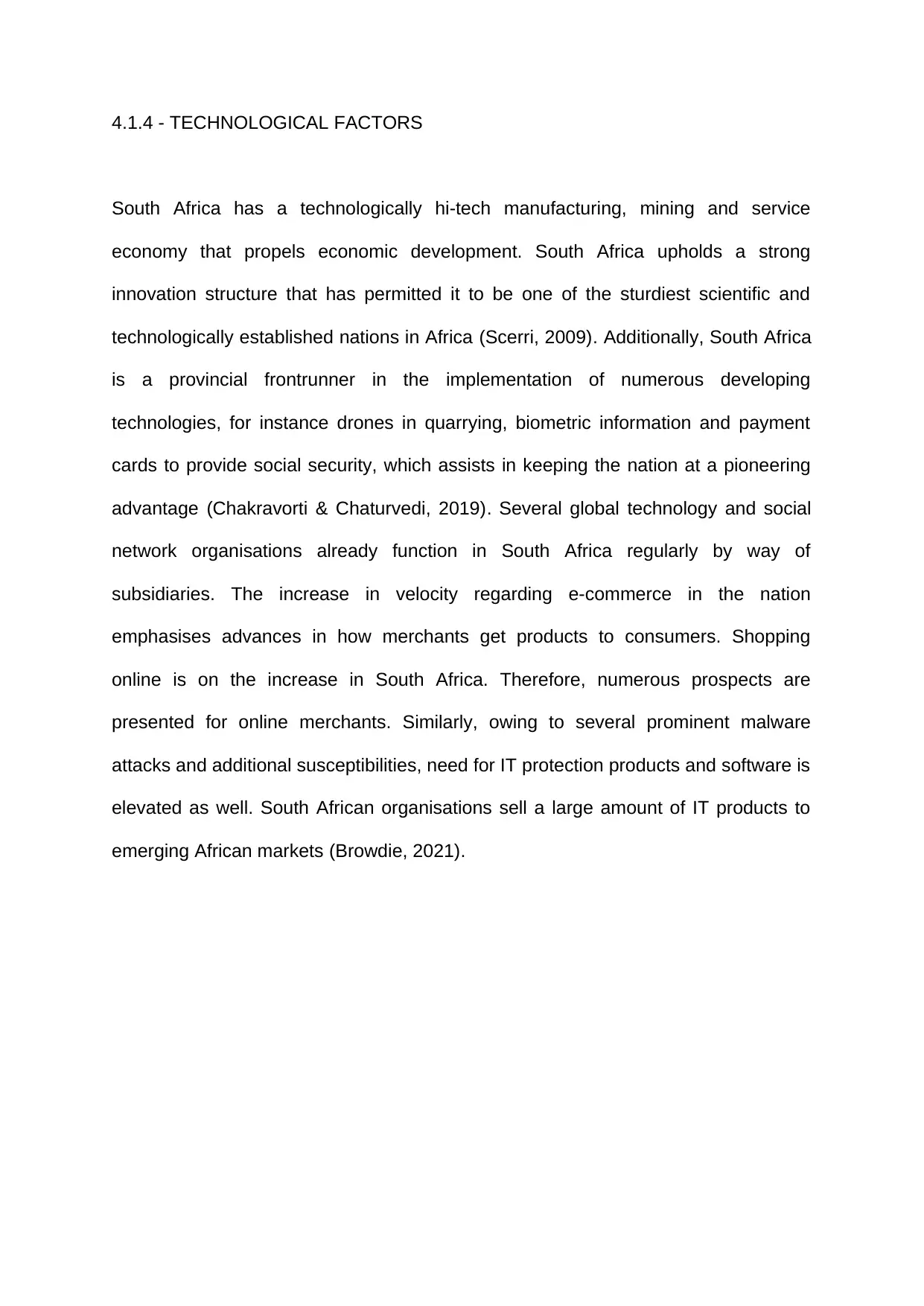
4.1.4 - TECHNOLOGICAL FACTORS
South Africa has a technologically hi-tech manufacturing, mining and service
economy that propels economic development. South Africa upholds a strong
innovation structure that has permitted it to be one of the sturdiest scientific and
technologically established nations in Africa (Scerri, 2009). Additionally, South Africa
is a provincial frontrunner in the implementation of numerous developing
technologies, for instance drones in quarrying, biometric information and payment
cards to provide social security, which assists in keeping the nation at a pioneering
advantage (Chakravorti & Chaturvedi, 2019). Several global technology and social
network organisations already function in South Africa regularly by way of
subsidiaries. The increase in velocity regarding e-commerce in the nation
emphasises advances in how merchants get products to consumers. Shopping
online is on the increase in South Africa. Therefore, numerous prospects are
presented for online merchants. Similarly, owing to several prominent malware
attacks and additional susceptibilities, need for IT protection products and software is
elevated as well. South African organisations sell a large amount of IT products to
emerging African markets (Browdie, 2021).
South Africa has a technologically hi-tech manufacturing, mining and service
economy that propels economic development. South Africa upholds a strong
innovation structure that has permitted it to be one of the sturdiest scientific and
technologically established nations in Africa (Scerri, 2009). Additionally, South Africa
is a provincial frontrunner in the implementation of numerous developing
technologies, for instance drones in quarrying, biometric information and payment
cards to provide social security, which assists in keeping the nation at a pioneering
advantage (Chakravorti & Chaturvedi, 2019). Several global technology and social
network organisations already function in South Africa regularly by way of
subsidiaries. The increase in velocity regarding e-commerce in the nation
emphasises advances in how merchants get products to consumers. Shopping
online is on the increase in South Africa. Therefore, numerous prospects are
presented for online merchants. Similarly, owing to several prominent malware
attacks and additional susceptibilities, need for IT protection products and software is
elevated as well. South African organisations sell a large amount of IT products to
emerging African markets (Browdie, 2021).
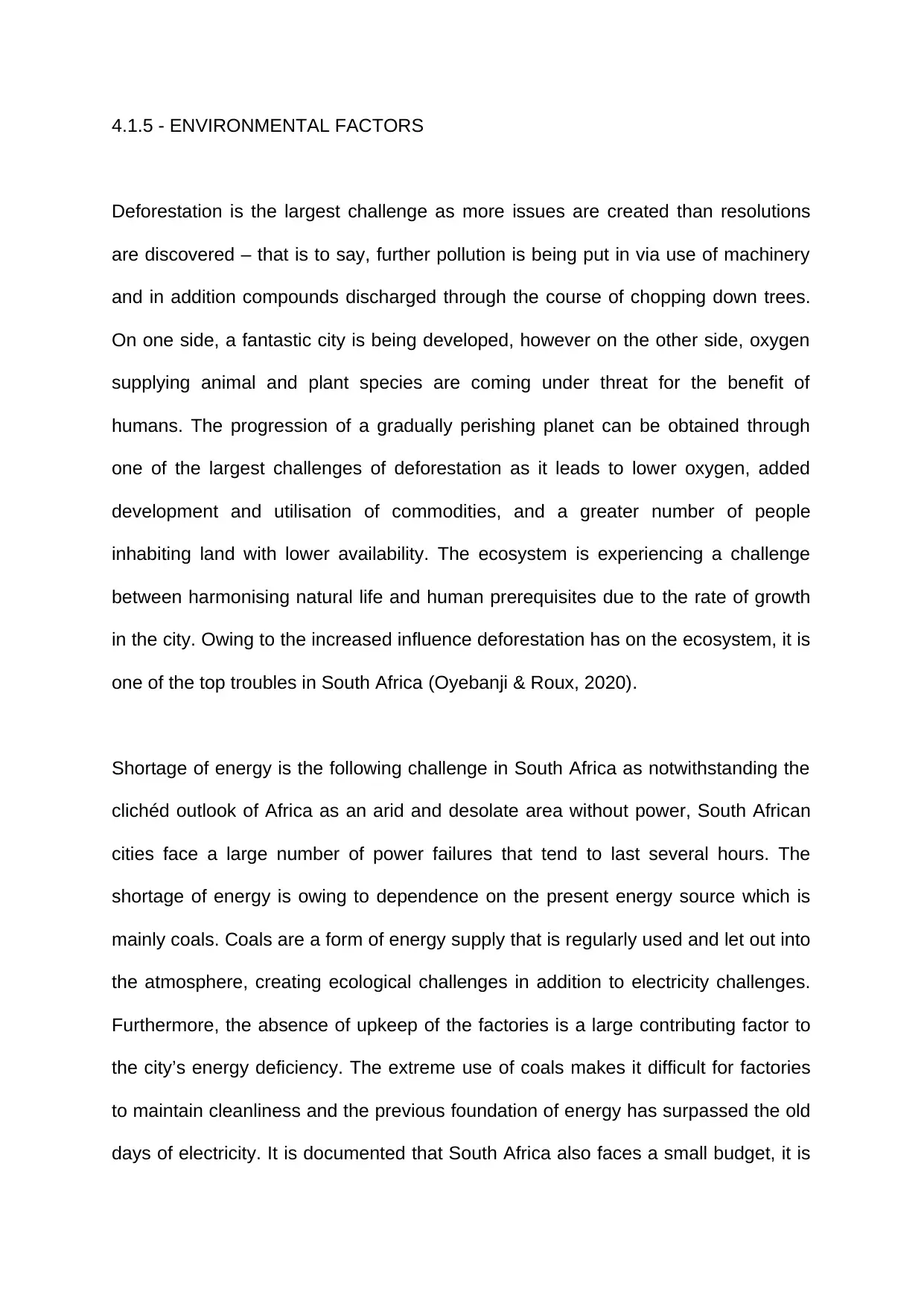
4.1.5 - ENVIRONMENTAL FACTORS
Deforestation is the largest challenge as more issues are created than resolutions
are discovered – that is to say, further pollution is being put in via use of machinery
and in addition compounds discharged through the course of chopping down trees.
On one side, a fantastic city is being developed, however on the other side, oxygen
supplying animal and plant species are coming under threat for the benefit of
humans. The progression of a gradually perishing planet can be obtained through
one of the largest challenges of deforestation as it leads to lower oxygen, added
development and utilisation of commodities, and a greater number of people
inhabiting land with lower availability. The ecosystem is experiencing a challenge
between harmonising natural life and human prerequisites due to the rate of growth
in the city. Owing to the increased influence deforestation has on the ecosystem, it is
one of the top troubles in South Africa (Oyebanji & Roux, 2020).
Shortage of energy is the following challenge in South Africa as notwithstanding the
clichéd outlook of Africa as an arid and desolate area without power, South African
cities face a large number of power failures that tend to last several hours. The
shortage of energy is owing to dependence on the present energy source which is
mainly coals. Coals are a form of energy supply that is regularly used and let out into
the atmosphere, creating ecological challenges in addition to electricity challenges.
Furthermore, the absence of upkeep of the factories is a large contributing factor to
the city’s energy deficiency. The extreme use of coals makes it difficult for factories
to maintain cleanliness and the previous foundation of energy has surpassed the old
days of electricity. It is documented that South Africa also faces a small budget, it is
Deforestation is the largest challenge as more issues are created than resolutions
are discovered – that is to say, further pollution is being put in via use of machinery
and in addition compounds discharged through the course of chopping down trees.
On one side, a fantastic city is being developed, however on the other side, oxygen
supplying animal and plant species are coming under threat for the benefit of
humans. The progression of a gradually perishing planet can be obtained through
one of the largest challenges of deforestation as it leads to lower oxygen, added
development and utilisation of commodities, and a greater number of people
inhabiting land with lower availability. The ecosystem is experiencing a challenge
between harmonising natural life and human prerequisites due to the rate of growth
in the city. Owing to the increased influence deforestation has on the ecosystem, it is
one of the top troubles in South Africa (Oyebanji & Roux, 2020).
Shortage of energy is the following challenge in South Africa as notwithstanding the
clichéd outlook of Africa as an arid and desolate area without power, South African
cities face a large number of power failures that tend to last several hours. The
shortage of energy is owing to dependence on the present energy source which is
mainly coals. Coals are a form of energy supply that is regularly used and let out into
the atmosphere, creating ecological challenges in addition to electricity challenges.
Furthermore, the absence of upkeep of the factories is a large contributing factor to
the city’s energy deficiency. The extreme use of coals makes it difficult for factories
to maintain cleanliness and the previous foundation of energy has surpassed the old
days of electricity. It is documented that South Africa also faces a small budget, it is
Paraphrase This Document
Need a fresh take? Get an instant paraphrase of this document with our AI Paraphraser

easily understood that a higher priced maintenance factory and a small electrical
budget can bring forth challenges such as power outages and energy deficiency in a
large city like South Africa (Burton, et al., 2018).
Pollution has the smallest impact, but nonetheless, has a momentous effect on
South Africa’s ecosystem. Exclusive of land deforestation, pollution would be lower.
Yet it remains a significant challenge due to the influence it has in regards to micro
and macroclimate. The prevalent use of vehicles has brought about an increased
level of traffic in South Africa. The high number of vehicles adds to water and air
pollution as gases are released from exhausts and vehicle oil is discarded into
waterways. A large amount of oil is brought into South Africa, as a result, further
pollution follows when oil slicks and discarding of oil ensues. Due to the city’s large
population, the regular use of oil generates further pollution (Thabethe, et al., 2021).
budget can bring forth challenges such as power outages and energy deficiency in a
large city like South Africa (Burton, et al., 2018).
Pollution has the smallest impact, but nonetheless, has a momentous effect on
South Africa’s ecosystem. Exclusive of land deforestation, pollution would be lower.
Yet it remains a significant challenge due to the influence it has in regards to micro
and macroclimate. The prevalent use of vehicles has brought about an increased
level of traffic in South Africa. The high number of vehicles adds to water and air
pollution as gases are released from exhausts and vehicle oil is discarded into
waterways. A large amount of oil is brought into South Africa, as a result, further
pollution follows when oil slicks and discarding of oil ensues. Due to the city’s large
population, the regular use of oil generates further pollution (Thabethe, et al., 2021).
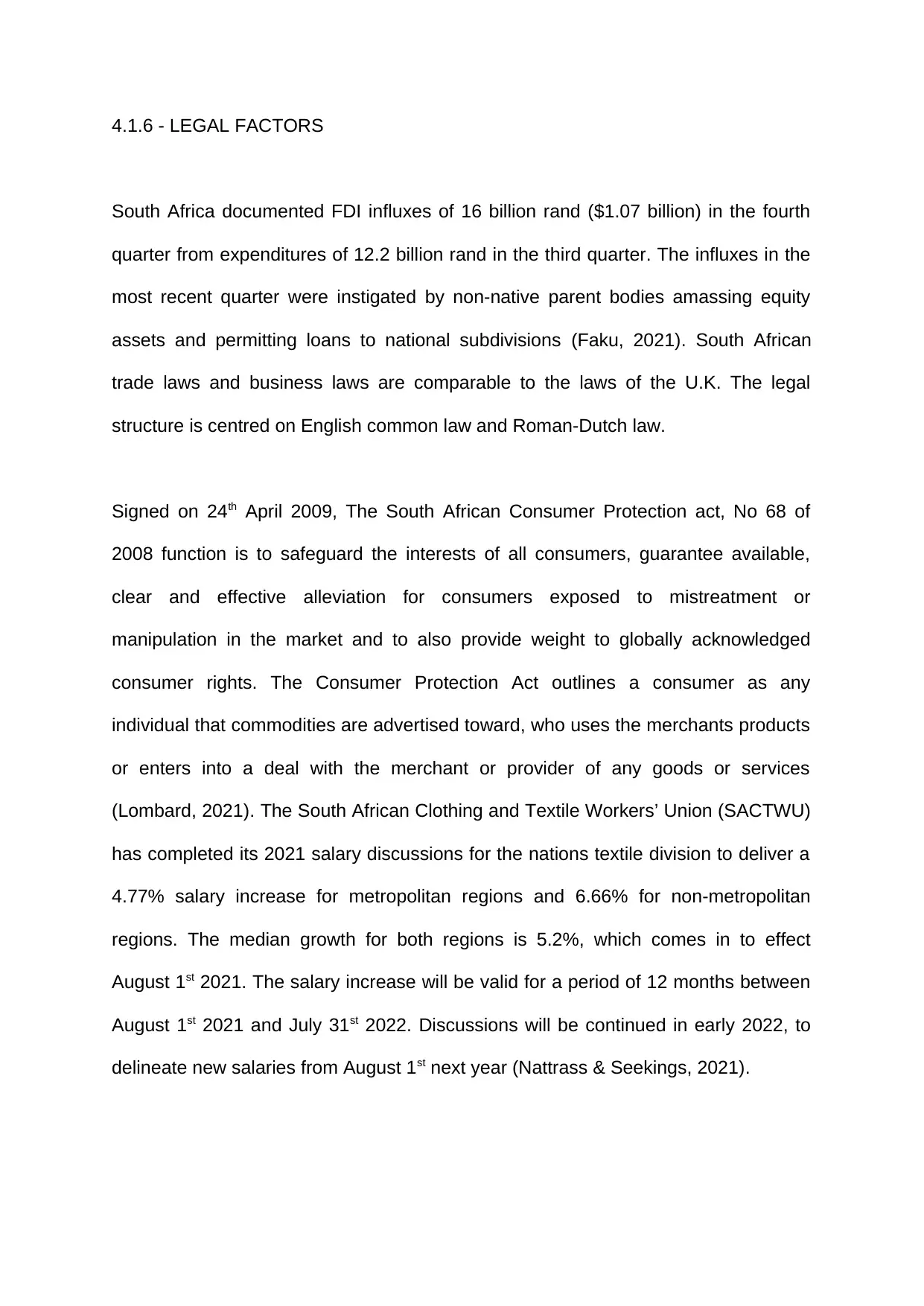
4.1.6 - LEGAL FACTORS
South Africa documented FDI influxes of 16 billion rand ($1.07 billion) in the fourth
quarter from expenditures of 12.2 billion rand in the third quarter. The influxes in the
most recent quarter were instigated by non-native parent bodies amassing equity
assets and permitting loans to national subdivisions (Faku, 2021). South African
trade laws and business laws are comparable to the laws of the U.K. The legal
structure is centred on English common law and Roman-Dutch law.
Signed on 24th April 2009, The South African Consumer Protection act, No 68 of
2008 function is to safeguard the interests of all consumers, guarantee available,
clear and effective alleviation for consumers exposed to mistreatment or
manipulation in the market and to also provide weight to globally acknowledged
consumer rights. The Consumer Protection Act outlines a consumer as any
individual that commodities are advertised toward, who uses the merchants products
or enters into a deal with the merchant or provider of any goods or services
(Lombard, 2021). The South African Clothing and Textile Workers’ Union (SACTWU)
has completed its 2021 salary discussions for the nations textile division to deliver a
4.77% salary increase for metropolitan regions and 6.66% for non-metropolitan
regions. The median growth for both regions is 5.2%, which comes in to effect
August 1st 2021. The salary increase will be valid for a period of 12 months between
August 1st 2021 and July 31st 2022. Discussions will be continued in early 2022, to
delineate new salaries from August 1st next year (Nattrass & Seekings, 2021).
South Africa documented FDI influxes of 16 billion rand ($1.07 billion) in the fourth
quarter from expenditures of 12.2 billion rand in the third quarter. The influxes in the
most recent quarter were instigated by non-native parent bodies amassing equity
assets and permitting loans to national subdivisions (Faku, 2021). South African
trade laws and business laws are comparable to the laws of the U.K. The legal
structure is centred on English common law and Roman-Dutch law.
Signed on 24th April 2009, The South African Consumer Protection act, No 68 of
2008 function is to safeguard the interests of all consumers, guarantee available,
clear and effective alleviation for consumers exposed to mistreatment or
manipulation in the market and to also provide weight to globally acknowledged
consumer rights. The Consumer Protection Act outlines a consumer as any
individual that commodities are advertised toward, who uses the merchants products
or enters into a deal with the merchant or provider of any goods or services
(Lombard, 2021). The South African Clothing and Textile Workers’ Union (SACTWU)
has completed its 2021 salary discussions for the nations textile division to deliver a
4.77% salary increase for metropolitan regions and 6.66% for non-metropolitan
regions. The median growth for both regions is 5.2%, which comes in to effect
August 1st 2021. The salary increase will be valid for a period of 12 months between
August 1st 2021 and July 31st 2022. Discussions will be continued in early 2022, to
delineate new salaries from August 1st next year (Nattrass & Seekings, 2021).
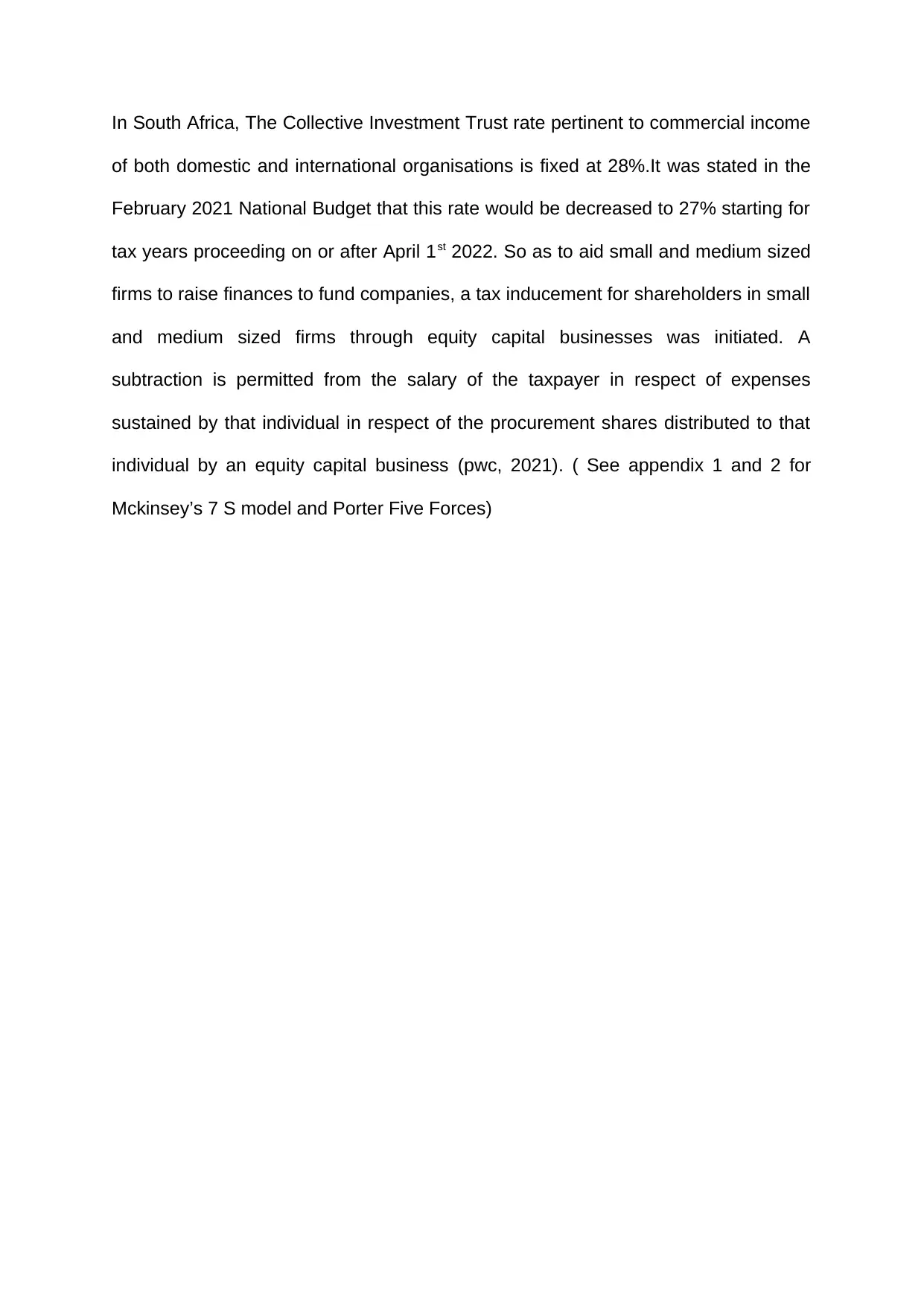
In South Africa, The Collective Investment Trust rate pertinent to commercial income
of both domestic and international organisations is fixed at 28%.It was stated in the
February 2021 National Budget that this rate would be decreased to 27% starting for
tax years proceeding on or after April 1st 2022. So as to aid small and medium sized
firms to raise finances to fund companies, a tax inducement for shareholders in small
and medium sized firms through equity capital businesses was initiated. A
subtraction is permitted from the salary of the taxpayer in respect of expenses
sustained by that individual in respect of the procurement shares distributed to that
individual by an equity capital business (pwc, 2021). ( See appendix 1 and 2 for
Mckinsey’s 7 S model and Porter Five Forces)
of both domestic and international organisations is fixed at 28%.It was stated in the
February 2021 National Budget that this rate would be decreased to 27% starting for
tax years proceeding on or after April 1st 2022. So as to aid small and medium sized
firms to raise finances to fund companies, a tax inducement for shareholders in small
and medium sized firms through equity capital businesses was initiated. A
subtraction is permitted from the salary of the taxpayer in respect of expenses
sustained by that individual in respect of the procurement shares distributed to that
individual by an equity capital business (pwc, 2021). ( See appendix 1 and 2 for
Mckinsey’s 7 S model and Porter Five Forces)
Secure Best Marks with AI Grader
Need help grading? Try our AI Grader for instant feedback on your assignments.

5.0 - MARKETING OBJECTIVES
Inaugurate Stables operation in the South African Marketplace
Grow brand familiarity in Johannesburg, South Africa by 10% by the end of
2022
Survival strategy
Growth strategy
Grow market penetration by above or equivalent to 5% by the end of 2022
Grow total sales by above or equivalent to 10% by the end of 2022
Growth brand familiarity by more or equal to 50% by the end of 2024
Inaugurate Stables operation in the South African Marketplace
Grow brand familiarity in Johannesburg, South Africa by 10% by the end of
2022
Survival strategy
Growth strategy
Grow market penetration by above or equivalent to 5% by the end of 2022
Grow total sales by above or equivalent to 10% by the end of 2022
Growth brand familiarity by more or equal to 50% by the end of 2024
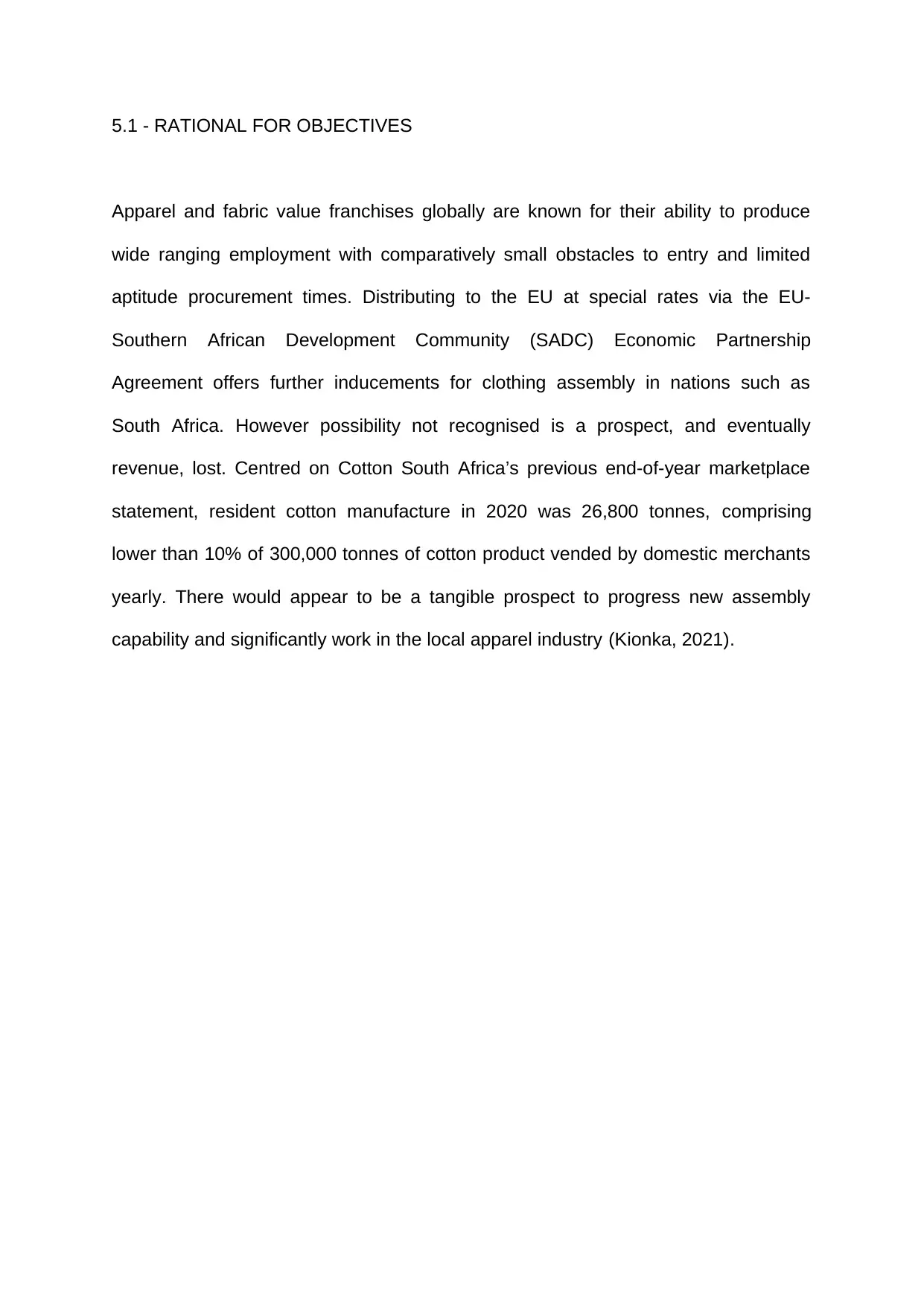
5.1 - RATIONAL FOR OBJECTIVES
Apparel and fabric value franchises globally are known for their ability to produce
wide ranging employment with comparatively small obstacles to entry and limited
aptitude procurement times. Distributing to the EU at special rates via the EU-
Southern African Development Community (SADC) Economic Partnership
Agreement offers further inducements for clothing assembly in nations such as
South Africa. However possibility not recognised is a prospect, and eventually
revenue, lost. Centred on Cotton South Africa’s previous end-of-year marketplace
statement, resident cotton manufacture in 2020 was 26,800 tonnes, comprising
lower than 10% of 300,000 tonnes of cotton product vended by domestic merchants
yearly. There would appear to be a tangible prospect to progress new assembly
capability and significantly work in the local apparel industry (Kionka, 2021).
Apparel and fabric value franchises globally are known for their ability to produce
wide ranging employment with comparatively small obstacles to entry and limited
aptitude procurement times. Distributing to the EU at special rates via the EU-
Southern African Development Community (SADC) Economic Partnership
Agreement offers further inducements for clothing assembly in nations such as
South Africa. However possibility not recognised is a prospect, and eventually
revenue, lost. Centred on Cotton South Africa’s previous end-of-year marketplace
statement, resident cotton manufacture in 2020 was 26,800 tonnes, comprising
lower than 10% of 300,000 tonnes of cotton product vended by domestic merchants
yearly. There would appear to be a tangible prospect to progress new assembly
capability and significantly work in the local apparel industry (Kionka, 2021).
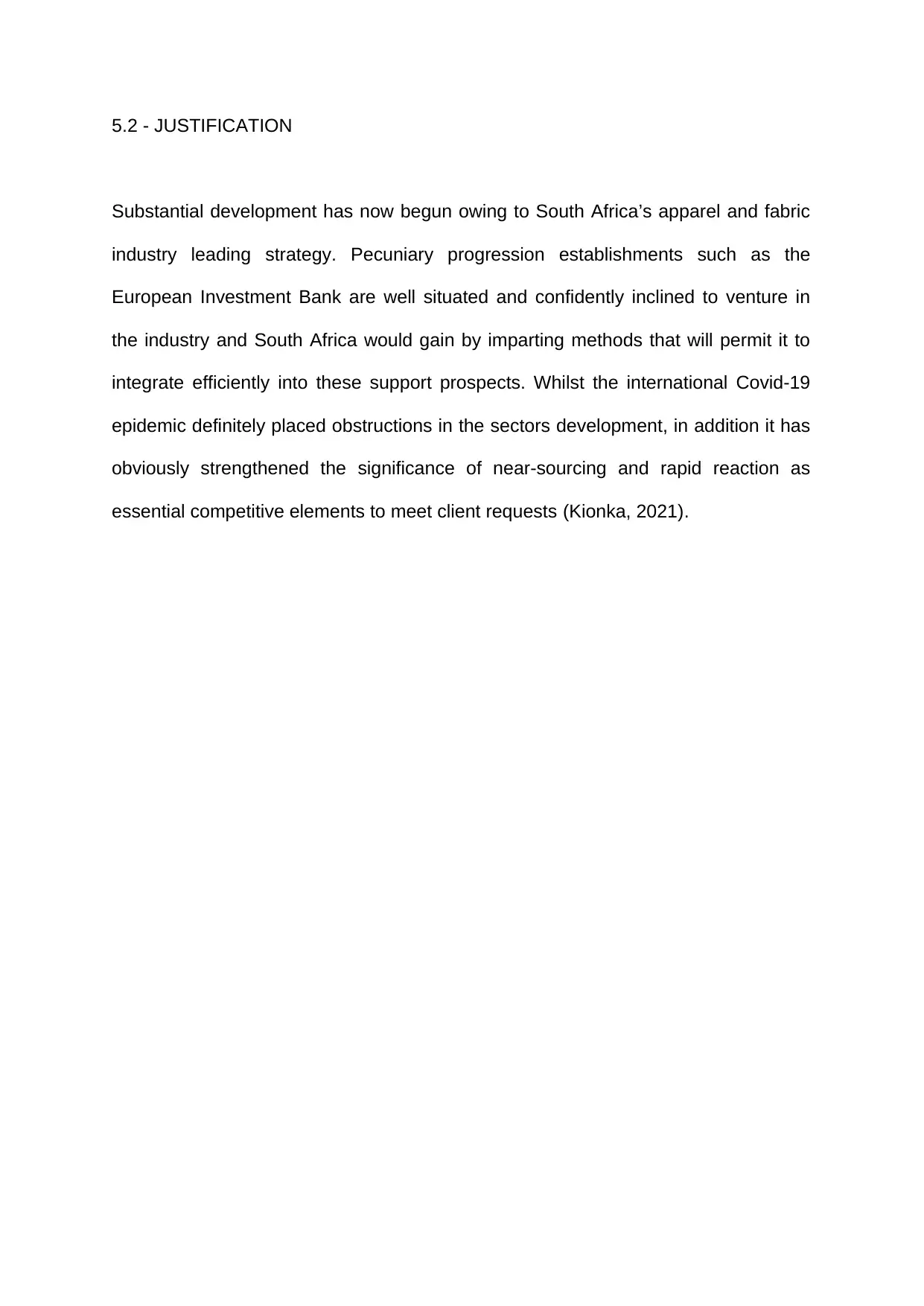
5.2 - JUSTIFICATION
Substantial development has now begun owing to South Africa’s apparel and fabric
industry leading strategy. Pecuniary progression establishments such as the
European Investment Bank are well situated and confidently inclined to venture in
the industry and South Africa would gain by imparting methods that will permit it to
integrate efficiently into these support prospects. Whilst the international Covid-19
epidemic definitely placed obstructions in the sectors development, in addition it has
obviously strengthened the significance of near-sourcing and rapid reaction as
essential competitive elements to meet client requests (Kionka, 2021).
Substantial development has now begun owing to South Africa’s apparel and fabric
industry leading strategy. Pecuniary progression establishments such as the
European Investment Bank are well situated and confidently inclined to venture in
the industry and South Africa would gain by imparting methods that will permit it to
integrate efficiently into these support prospects. Whilst the international Covid-19
epidemic definitely placed obstructions in the sectors development, in addition it has
obviously strengthened the significance of near-sourcing and rapid reaction as
essential competitive elements to meet client requests (Kionka, 2021).
Paraphrase This Document
Need a fresh take? Get an instant paraphrase of this document with our AI Paraphraser
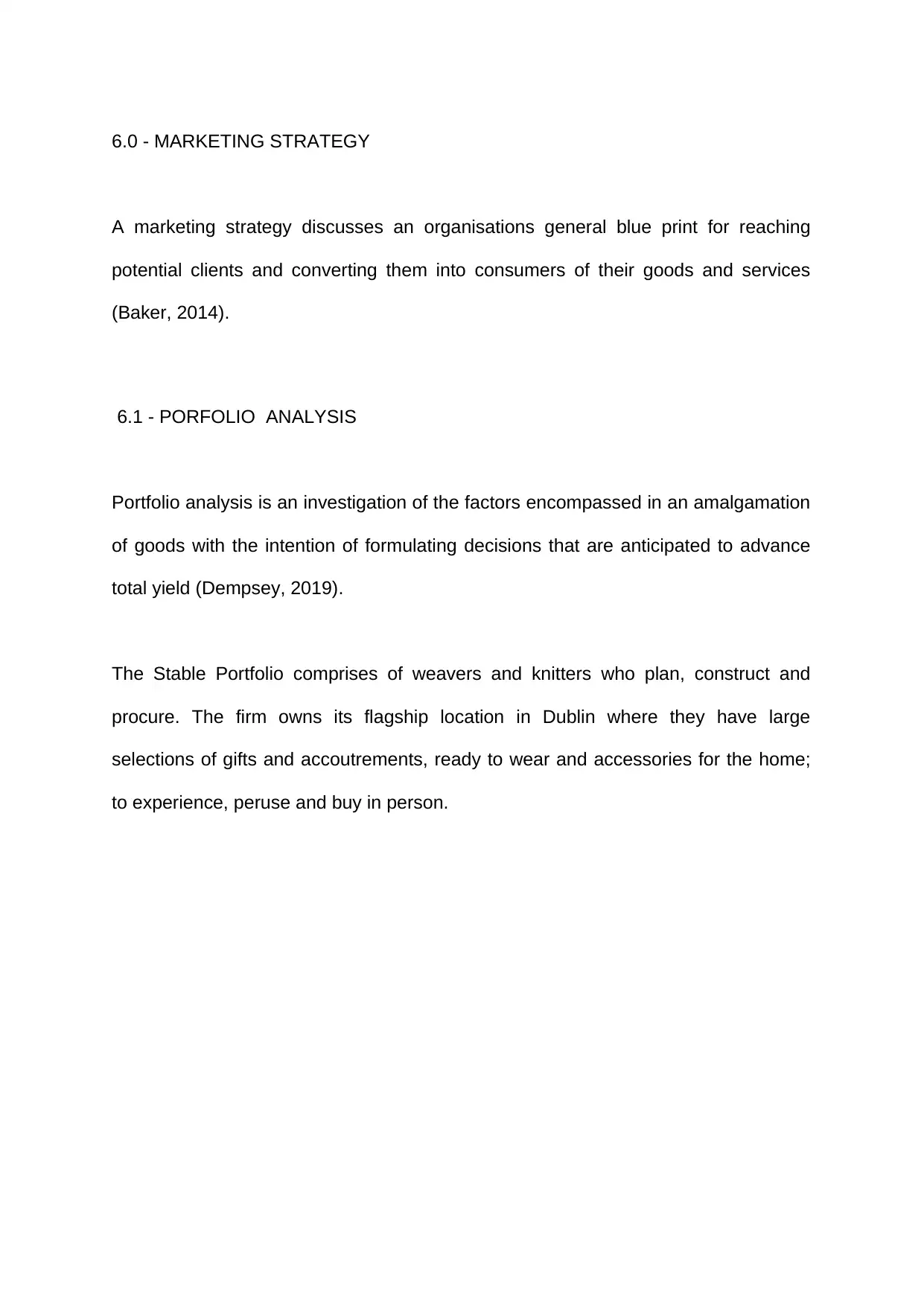
6.0 - MARKETING STRATEGY
A marketing strategy discusses an organisations general blue print for reaching
potential clients and converting them into consumers of their goods and services
(Baker, 2014).
6.1 - PORFOLIO ANALYSIS
Portfolio analysis is an investigation of the factors encompassed in an amalgamation
of goods with the intention of formulating decisions that are anticipated to advance
total yield (Dempsey, 2019).
The Stable Portfolio comprises of weavers and knitters who plan, construct and
procure. The firm owns its flagship location in Dublin where they have large
selections of gifts and accoutrements, ready to wear and accessories for the home;
to experience, peruse and buy in person.
A marketing strategy discusses an organisations general blue print for reaching
potential clients and converting them into consumers of their goods and services
(Baker, 2014).
6.1 - PORFOLIO ANALYSIS
Portfolio analysis is an investigation of the factors encompassed in an amalgamation
of goods with the intention of formulating decisions that are anticipated to advance
total yield (Dempsey, 2019).
The Stable Portfolio comprises of weavers and knitters who plan, construct and
procure. The firm owns its flagship location in Dublin where they have large
selections of gifts and accoutrements, ready to wear and accessories for the home;
to experience, peruse and buy in person.
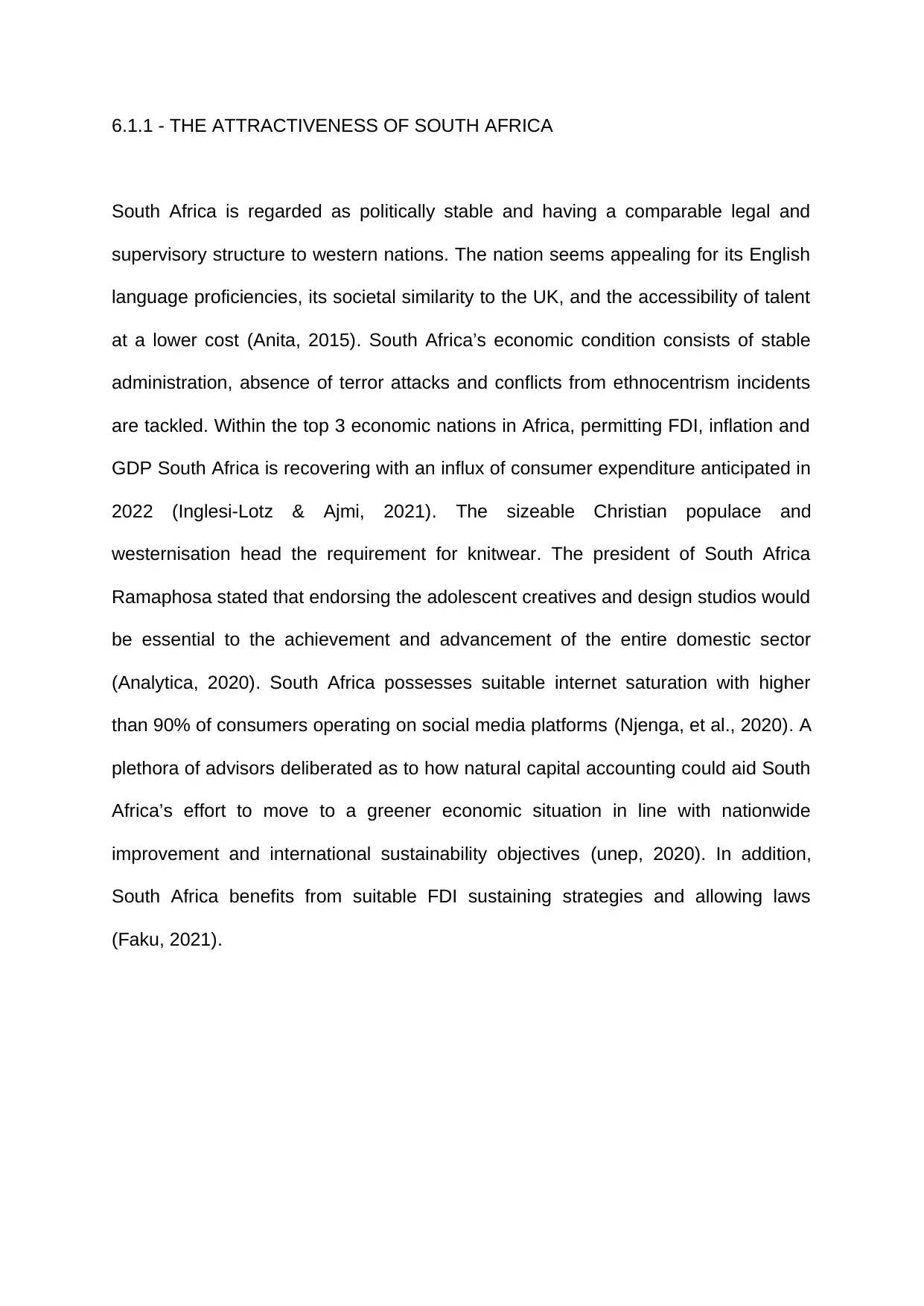
6.1.1 - THE ATTRACTIVENESS OF SOUTH AFRICA
South Africa is regarded as politically stable and having a comparable legal and
supervisory structure to western nations. The nation seems appealing for its English
language proficiencies, its societal similarity to the UK, and the accessibility of talent
at a lower cost (Anita, 2015). South Africa’s economic condition consists of stable
administration, absence of terror attacks and conflicts from ethnocentrism incidents
are tackled. Within the top 3 economic nations in Africa, permitting FDI, inflation and
GDP South Africa is recovering with an influx of consumer expenditure anticipated in
2022 (Inglesi-Lotz & Ajmi, 2021). The sizeable Christian populace and
westernisation head the requirement for knitwear. The president of South Africa
Ramaphosa stated that endorsing the adolescent creatives and design studios would
be essential to the achievement and advancement of the entire domestic sector
(Analytica, 2020). South Africa possesses suitable internet saturation with higher
than 90% of consumers operating on social media platforms (Njenga, et al., 2020). A
plethora of advisors deliberated as to how natural capital accounting could aid South
Africa’s effort to move to a greener economic situation in line with nationwide
improvement and international sustainability objectives (unep, 2020). In addition,
South Africa benefits from suitable FDI sustaining strategies and allowing laws
(Faku, 2021).
South Africa is regarded as politically stable and having a comparable legal and
supervisory structure to western nations. The nation seems appealing for its English
language proficiencies, its societal similarity to the UK, and the accessibility of talent
at a lower cost (Anita, 2015). South Africa’s economic condition consists of stable
administration, absence of terror attacks and conflicts from ethnocentrism incidents
are tackled. Within the top 3 economic nations in Africa, permitting FDI, inflation and
GDP South Africa is recovering with an influx of consumer expenditure anticipated in
2022 (Inglesi-Lotz & Ajmi, 2021). The sizeable Christian populace and
westernisation head the requirement for knitwear. The president of South Africa
Ramaphosa stated that endorsing the adolescent creatives and design studios would
be essential to the achievement and advancement of the entire domestic sector
(Analytica, 2020). South Africa possesses suitable internet saturation with higher
than 90% of consumers operating on social media platforms (Njenga, et al., 2020). A
plethora of advisors deliberated as to how natural capital accounting could aid South
Africa’s effort to move to a greener economic situation in line with nationwide
improvement and international sustainability objectives (unep, 2020). In addition,
South Africa benefits from suitable FDI sustaining strategies and allowing laws
(Faku, 2021).
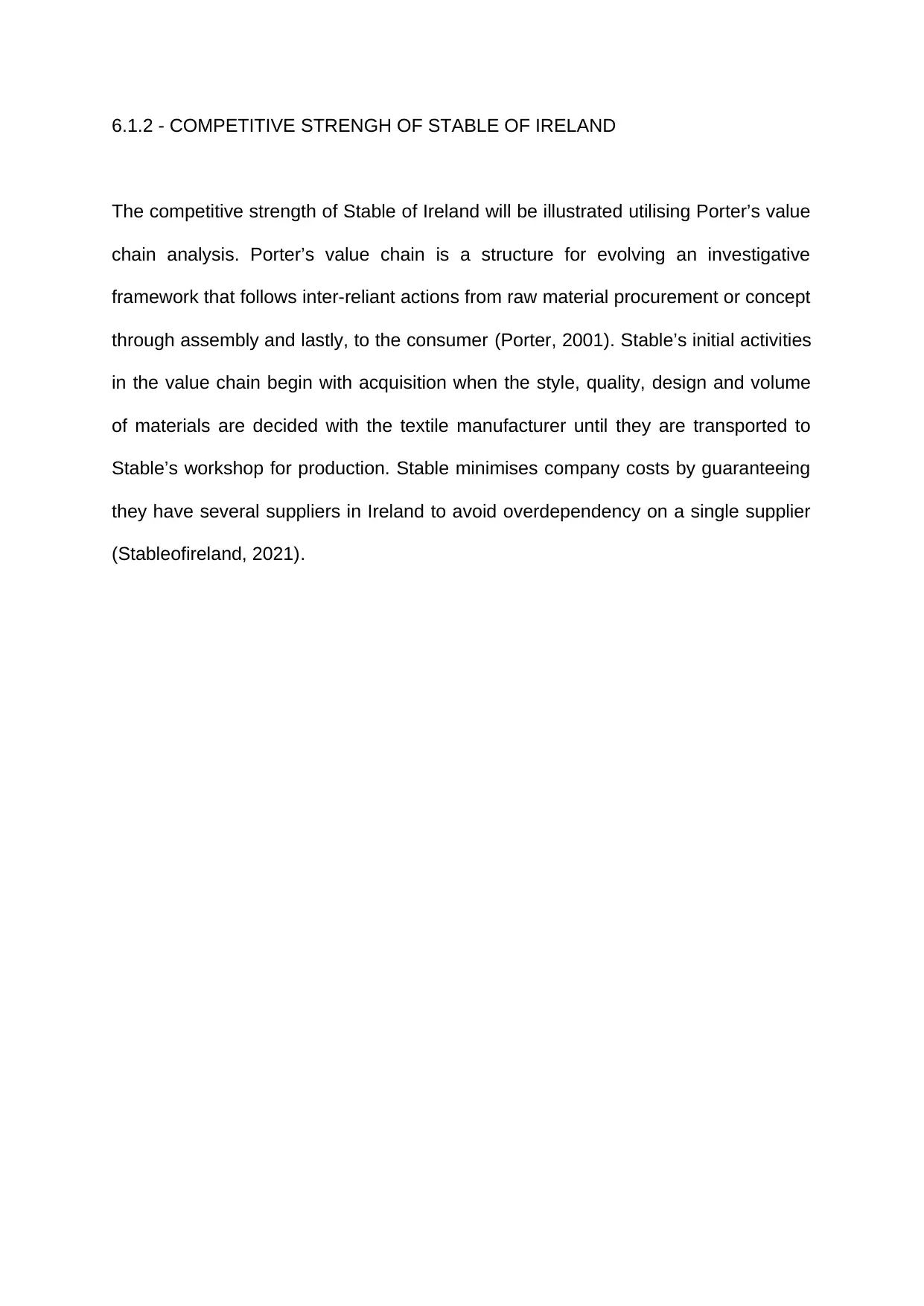
6.1.2 - COMPETITIVE STRENGH OF STABLE OF IRELAND
The competitive strength of Stable of Ireland will be illustrated utilising Porter’s value
chain analysis. Porter’s value chain is a structure for evolving an investigative
framework that follows inter-reliant actions from raw material procurement or concept
through assembly and lastly, to the consumer (Porter, 2001). Stable’s initial activities
in the value chain begin with acquisition when the style, quality, design and volume
of materials are decided with the textile manufacturer until they are transported to
Stable’s workshop for production. Stable minimises company costs by guaranteeing
they have several suppliers in Ireland to avoid overdependency on a single supplier
(Stableofireland, 2021).
The competitive strength of Stable of Ireland will be illustrated utilising Porter’s value
chain analysis. Porter’s value chain is a structure for evolving an investigative
framework that follows inter-reliant actions from raw material procurement or concept
through assembly and lastly, to the consumer (Porter, 2001). Stable’s initial activities
in the value chain begin with acquisition when the style, quality, design and volume
of materials are decided with the textile manufacturer until they are transported to
Stable’s workshop for production. Stable minimises company costs by guaranteeing
they have several suppliers in Ireland to avoid overdependency on a single supplier
(Stableofireland, 2021).
Secure Best Marks with AI Grader
Need help grading? Try our AI Grader for instant feedback on your assignments.
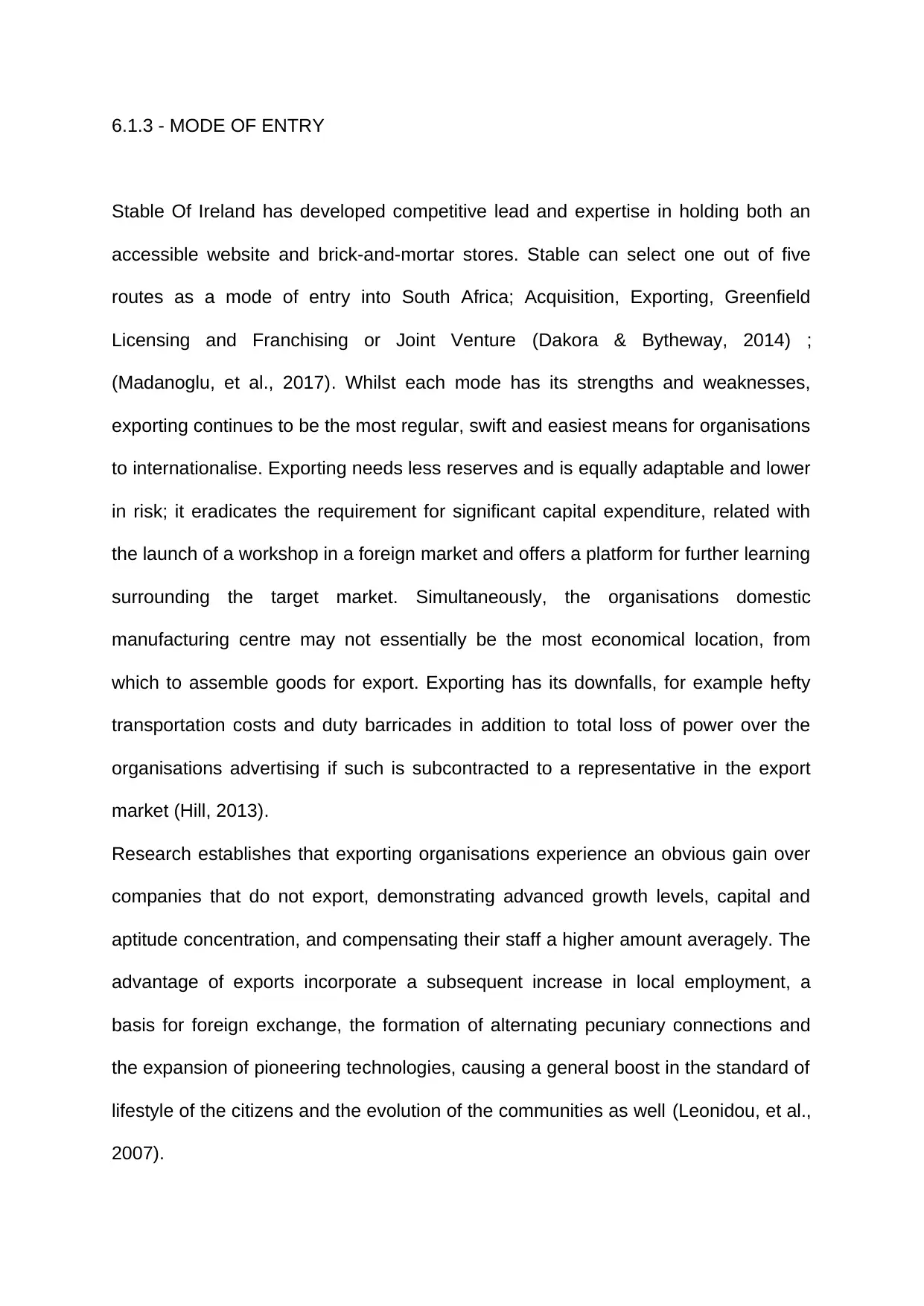
6.1.3 - MODE OF ENTRY
Stable Of Ireland has developed competitive lead and expertise in holding both an
accessible website and brick-and-mortar stores. Stable can select one out of five
routes as a mode of entry into South Africa; Acquisition, Exporting, Greenfield
Licensing and Franchising or Joint Venture (Dakora & Bytheway, 2014) ;
(Madanoglu, et al., 2017). Whilst each mode has its strengths and weaknesses,
exporting continues to be the most regular, swift and easiest means for organisations
to internationalise. Exporting needs less reserves and is equally adaptable and lower
in risk; it eradicates the requirement for significant capital expenditure, related with
the launch of a workshop in a foreign market and offers a platform for further learning
surrounding the target market. Simultaneously, the organisations domestic
manufacturing centre may not essentially be the most economical location, from
which to assemble goods for export. Exporting has its downfalls, for example hefty
transportation costs and duty barricades in addition to total loss of power over the
organisations advertising if such is subcontracted to a representative in the export
market (Hill, 2013).
Research establishes that exporting organisations experience an obvious gain over
companies that do not export, demonstrating advanced growth levels, capital and
aptitude concentration, and compensating their staff a higher amount averagely. The
advantage of exports incorporate a subsequent increase in local employment, a
basis for foreign exchange, the formation of alternating pecuniary connections and
the expansion of pioneering technologies, causing a general boost in the standard of
lifestyle of the citizens and the evolution of the communities as well (Leonidou, et al.,
2007).
Stable Of Ireland has developed competitive lead and expertise in holding both an
accessible website and brick-and-mortar stores. Stable can select one out of five
routes as a mode of entry into South Africa; Acquisition, Exporting, Greenfield
Licensing and Franchising or Joint Venture (Dakora & Bytheway, 2014) ;
(Madanoglu, et al., 2017). Whilst each mode has its strengths and weaknesses,
exporting continues to be the most regular, swift and easiest means for organisations
to internationalise. Exporting needs less reserves and is equally adaptable and lower
in risk; it eradicates the requirement for significant capital expenditure, related with
the launch of a workshop in a foreign market and offers a platform for further learning
surrounding the target market. Simultaneously, the organisations domestic
manufacturing centre may not essentially be the most economical location, from
which to assemble goods for export. Exporting has its downfalls, for example hefty
transportation costs and duty barricades in addition to total loss of power over the
organisations advertising if such is subcontracted to a representative in the export
market (Hill, 2013).
Research establishes that exporting organisations experience an obvious gain over
companies that do not export, demonstrating advanced growth levels, capital and
aptitude concentration, and compensating their staff a higher amount averagely. The
advantage of exports incorporate a subsequent increase in local employment, a
basis for foreign exchange, the formation of alternating pecuniary connections and
the expansion of pioneering technologies, causing a general boost in the standard of
lifestyle of the citizens and the evolution of the communities as well (Leonidou, et al.,
2007).
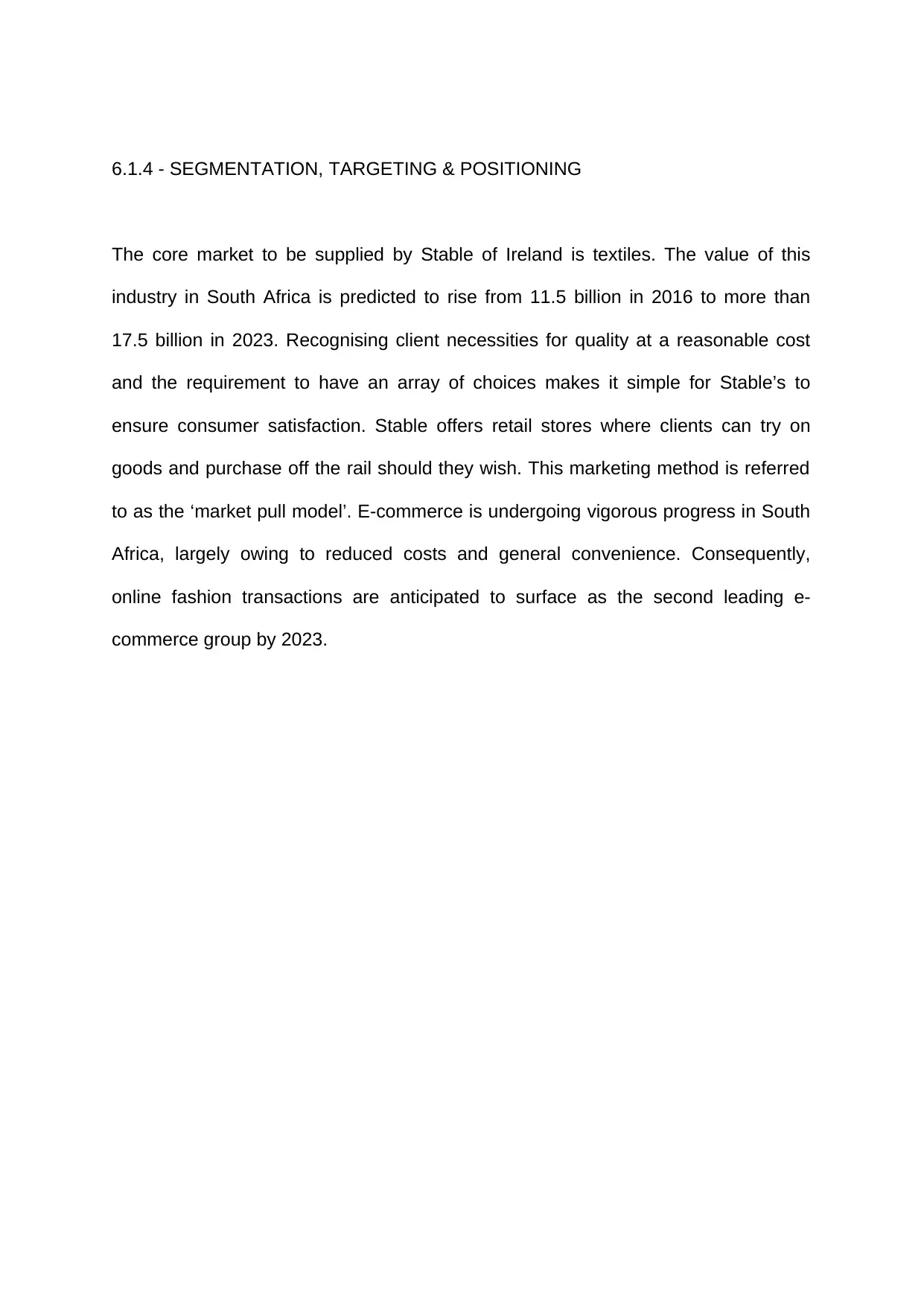
6.1.4 - SEGMENTATION, TARGETING & POSITIONING
The core market to be supplied by Stable of Ireland is textiles. The value of this
industry in South Africa is predicted to rise from 11.5 billion in 2016 to more than
17.5 billion in 2023. Recognising client necessities for quality at a reasonable cost
and the requirement to have an array of choices makes it simple for Stable’s to
ensure consumer satisfaction. Stable offers retail stores where clients can try on
goods and purchase off the rail should they wish. This marketing method is referred
to as the ‘market pull model’. E-commerce is undergoing vigorous progress in South
Africa, largely owing to reduced costs and general convenience. Consequently,
online fashion transactions are anticipated to surface as the second leading e-
commerce group by 2023.
The core market to be supplied by Stable of Ireland is textiles. The value of this
industry in South Africa is predicted to rise from 11.5 billion in 2016 to more than
17.5 billion in 2023. Recognising client necessities for quality at a reasonable cost
and the requirement to have an array of choices makes it simple for Stable’s to
ensure consumer satisfaction. Stable offers retail stores where clients can try on
goods and purchase off the rail should they wish. This marketing method is referred
to as the ‘market pull model’. E-commerce is undergoing vigorous progress in South
Africa, largely owing to reduced costs and general convenience. Consequently,
online fashion transactions are anticipated to surface as the second leading e-
commerce group by 2023.

7.0 - MARKETING TACTICS
Marketing tactics are a sequence or collection of tactical means or activities intended
to promote an organisations goods or services. The intention is to amplify sales and
sustain competitive trade (Rossiter, et al., 2018).
7.1 - PRODUCT
The standardisation approach is what Stable of Ireland will use to enter South Africa
market. Standardisation provides a unification of societies that have comparable
ecological and consumer requirements. Hence, an organisation considering
globalisation, applying a single tactic by standardising its marketing and goods mix
will afford consumers reliability and reduced operating expenses (Kaynak & Herbig,
2014). Though, the organisation will need to observe the industry fashion trends to
guarantee the goods are in fashion prior to standardisation.
Marketing tactics are a sequence or collection of tactical means or activities intended
to promote an organisations goods or services. The intention is to amplify sales and
sustain competitive trade (Rossiter, et al., 2018).
7.1 - PRODUCT
The standardisation approach is what Stable of Ireland will use to enter South Africa
market. Standardisation provides a unification of societies that have comparable
ecological and consumer requirements. Hence, an organisation considering
globalisation, applying a single tactic by standardising its marketing and goods mix
will afford consumers reliability and reduced operating expenses (Kaynak & Herbig,
2014). Though, the organisation will need to observe the industry fashion trends to
guarantee the goods are in fashion prior to standardisation.
Paraphrase This Document
Need a fresh take? Get an instant paraphrase of this document with our AI Paraphraser
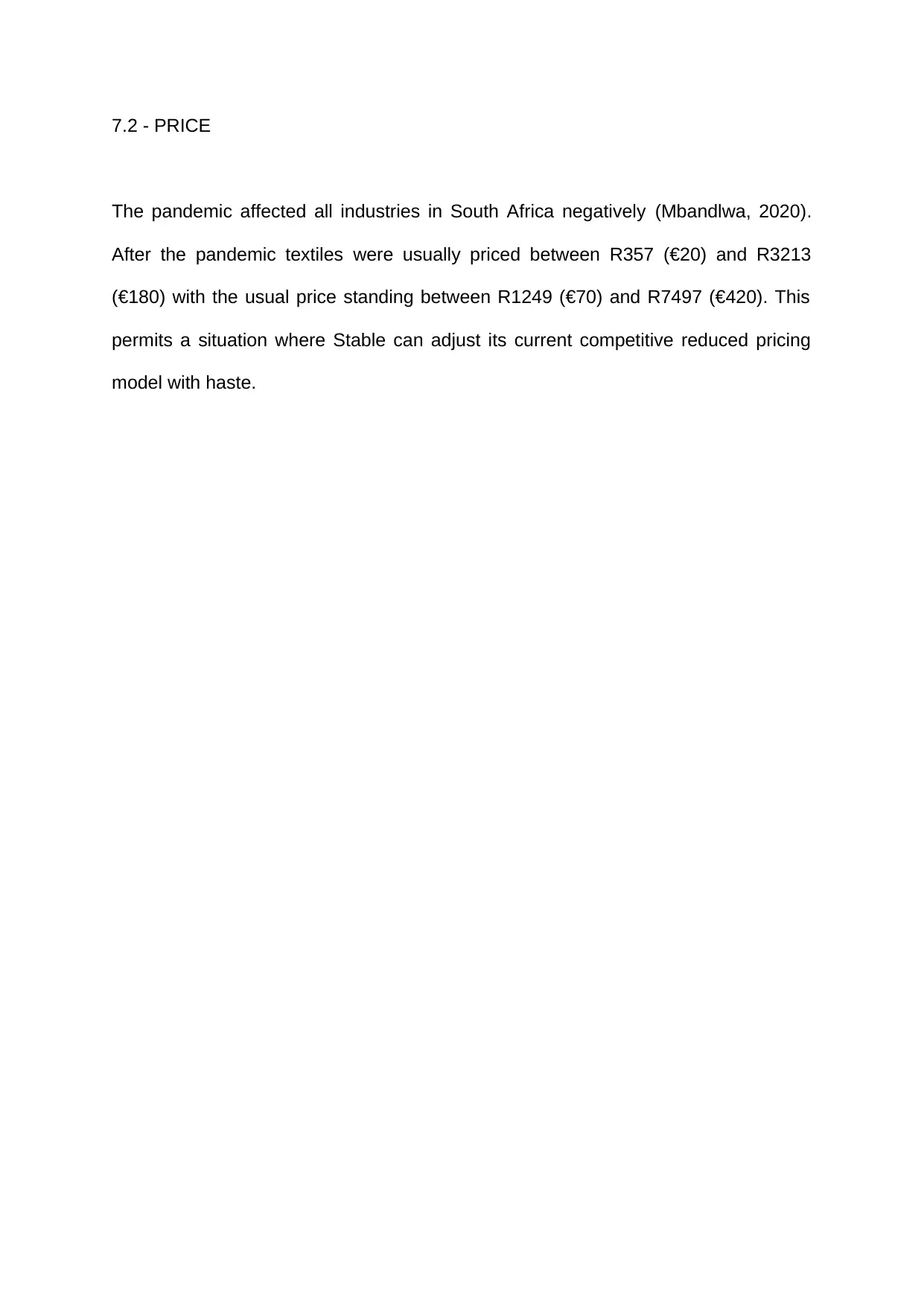
7.2 - PRICE
The pandemic affected all industries in South Africa negatively (Mbandlwa, 2020).
After the pandemic textiles were usually priced between R357 (€20) and R3213
(€180) with the usual price standing between R1249 (€70) and R7497 (€420). This
permits a situation where Stable can adjust its current competitive reduced pricing
model with haste.
The pandemic affected all industries in South Africa negatively (Mbandlwa, 2020).
After the pandemic textiles were usually priced between R357 (€20) and R3213
(€180) with the usual price standing between R1249 (€70) and R7497 (€420). This
permits a situation where Stable can adjust its current competitive reduced pricing
model with haste.
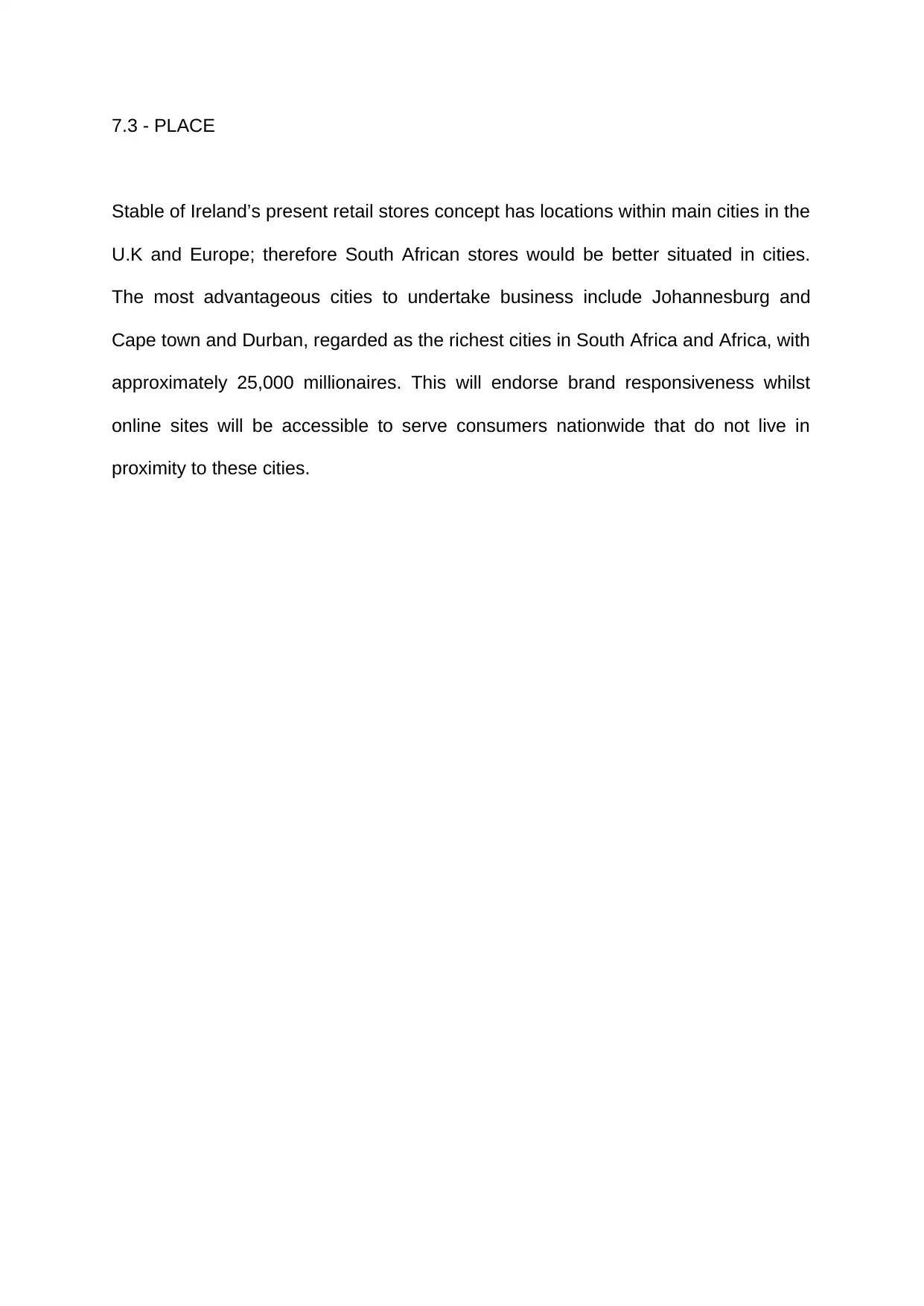
7.3 - PLACE
Stable of Ireland’s present retail stores concept has locations within main cities in the
U.K and Europe; therefore South African stores would be better situated in cities.
The most advantageous cities to undertake business include Johannesburg and
Cape town and Durban, regarded as the richest cities in South Africa and Africa, with
approximately 25,000 millionaires. This will endorse brand responsiveness whilst
online sites will be accessible to serve consumers nationwide that do not live in
proximity to these cities.
Stable of Ireland’s present retail stores concept has locations within main cities in the
U.K and Europe; therefore South African stores would be better situated in cities.
The most advantageous cities to undertake business include Johannesburg and
Cape town and Durban, regarded as the richest cities in South Africa and Africa, with
approximately 25,000 millionaires. This will endorse brand responsiveness whilst
online sites will be accessible to serve consumers nationwide that do not live in
proximity to these cities.
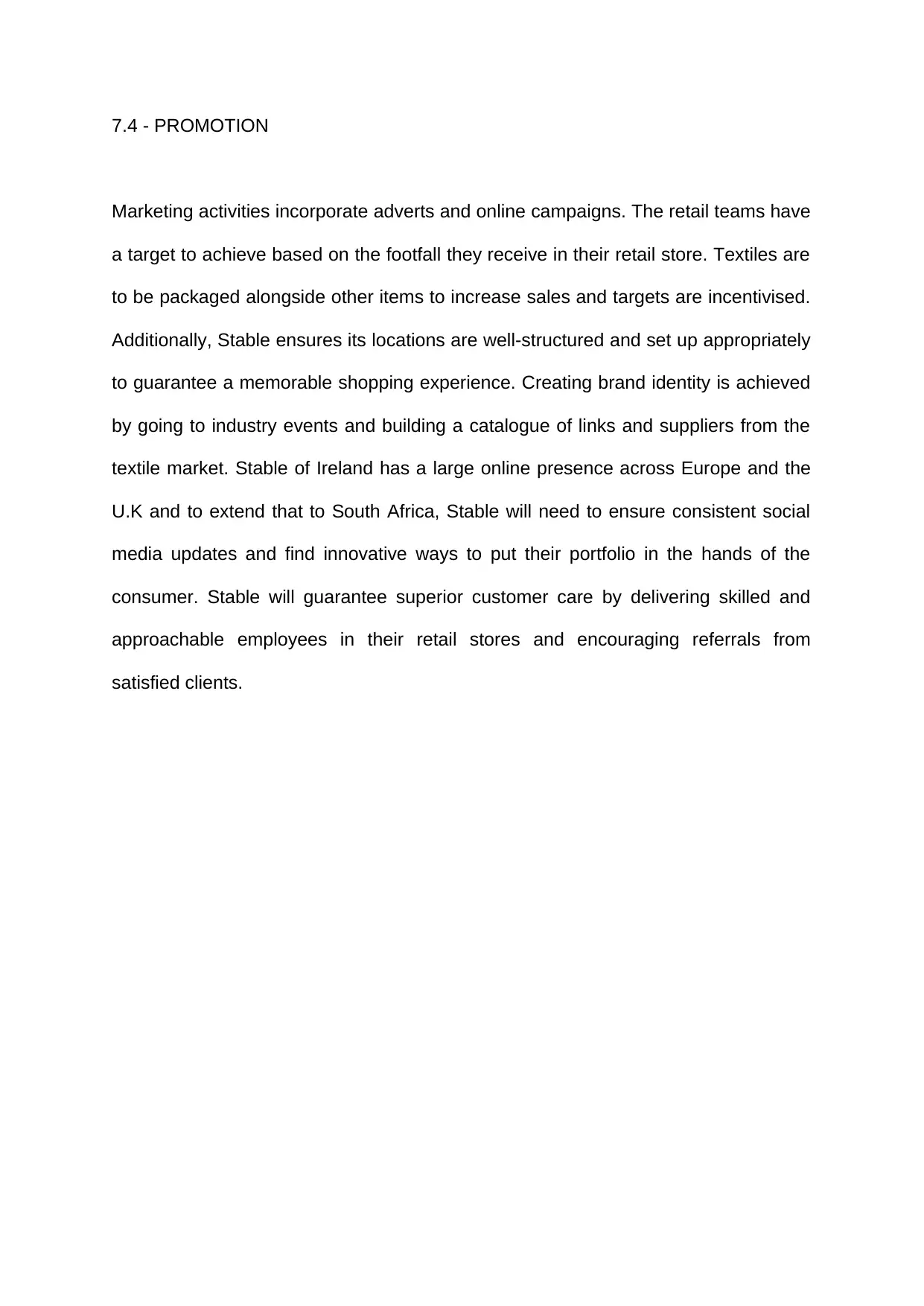
7.4 - PROMOTION
Marketing activities incorporate adverts and online campaigns. The retail teams have
a target to achieve based on the footfall they receive in their retail store. Textiles are
to be packaged alongside other items to increase sales and targets are incentivised.
Additionally, Stable ensures its locations are well-structured and set up appropriately
to guarantee a memorable shopping experience. Creating brand identity is achieved
by going to industry events and building a catalogue of links and suppliers from the
textile market. Stable of Ireland has a large online presence across Europe and the
U.K and to extend that to South Africa, Stable will need to ensure consistent social
media updates and find innovative ways to put their portfolio in the hands of the
consumer. Stable will guarantee superior customer care by delivering skilled and
approachable employees in their retail stores and encouraging referrals from
satisfied clients.
Marketing activities incorporate adverts and online campaigns. The retail teams have
a target to achieve based on the footfall they receive in their retail store. Textiles are
to be packaged alongside other items to increase sales and targets are incentivised.
Additionally, Stable ensures its locations are well-structured and set up appropriately
to guarantee a memorable shopping experience. Creating brand identity is achieved
by going to industry events and building a catalogue of links and suppliers from the
textile market. Stable of Ireland has a large online presence across Europe and the
U.K and to extend that to South Africa, Stable will need to ensure consistent social
media updates and find innovative ways to put their portfolio in the hands of the
consumer. Stable will guarantee superior customer care by delivering skilled and
approachable employees in their retail stores and encouraging referrals from
satisfied clients.
Secure Best Marks with AI Grader
Need help grading? Try our AI Grader for instant feedback on your assignments.
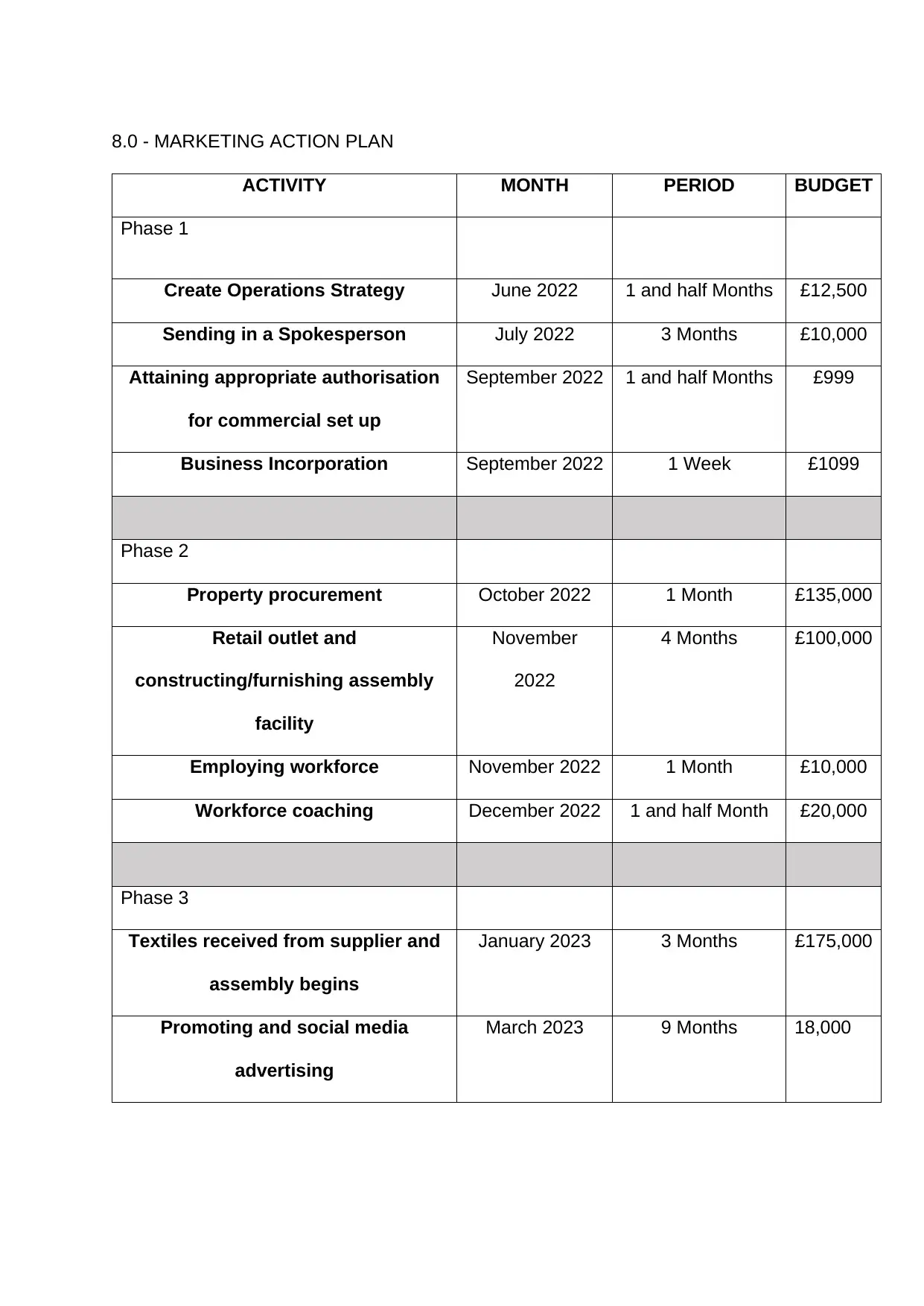
8.0 - MARKETING ACTION PLAN
ACTIVITY MONTH PERIOD BUDGET
Phase 1
Create Operations Strategy June 2022 1 and half Months £12,500
Sending in a Spokesperson July 2022 3 Months £10,000
Attaining appropriate authorisation
for commercial set up
September 2022 1 and half Months £999
Business Incorporation September 2022 1 Week £1099
Phase 2
Property procurement October 2022 1 Month £135,000
Retail outlet and
constructing/furnishing assembly
facility
November
2022
4 Months £100,000
Employing workforce November 2022 1 Month £10,000
Workforce coaching December 2022 1 and half Month £20,000
Phase 3
Textiles received from supplier and
assembly begins
January 2023 3 Months £175,000
Promoting and social media
advertising
March 2023 9 Months 18,000
ACTIVITY MONTH PERIOD BUDGET
Phase 1
Create Operations Strategy June 2022 1 and half Months £12,500
Sending in a Spokesperson July 2022 3 Months £10,000
Attaining appropriate authorisation
for commercial set up
September 2022 1 and half Months £999
Business Incorporation September 2022 1 Week £1099
Phase 2
Property procurement October 2022 1 Month £135,000
Retail outlet and
constructing/furnishing assembly
facility
November
2022
4 Months £100,000
Employing workforce November 2022 1 Month £10,000
Workforce coaching December 2022 1 and half Month £20,000
Phase 3
Textiles received from supplier and
assembly begins
January 2023 3 Months £175,000
Promoting and social media
advertising
March 2023 9 Months 18,000
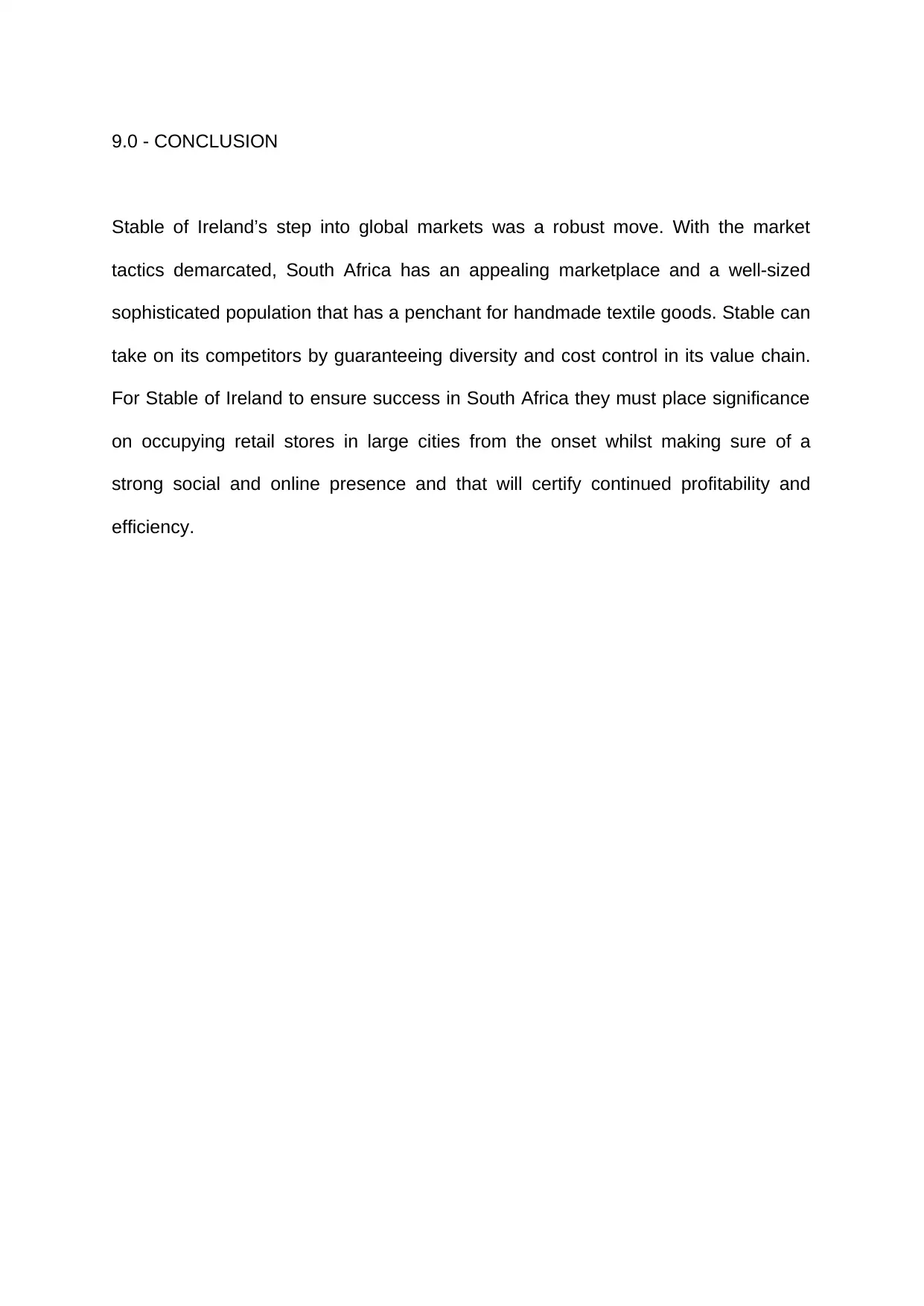
9.0 - CONCLUSION
Stable of Ireland’s step into global markets was a robust move. With the market
tactics demarcated, South Africa has an appealing marketplace and a well-sized
sophisticated population that has a penchant for handmade textile goods. Stable can
take on its competitors by guaranteeing diversity and cost control in its value chain.
For Stable of Ireland to ensure success in South Africa they must place significance
on occupying retail stores in large cities from the onset whilst making sure of a
strong social and online presence and that will certify continued profitability and
efficiency.
Stable of Ireland’s step into global markets was a robust move. With the market
tactics demarcated, South Africa has an appealing marketplace and a well-sized
sophisticated population that has a penchant for handmade textile goods. Stable can
take on its competitors by guaranteeing diversity and cost control in its value chain.
For Stable of Ireland to ensure success in South Africa they must place significance
on occupying retail stores in large cities from the onset whilst making sure of a
strong social and online presence and that will certify continued profitability and
efficiency.

10.0 - BIBLIOGRAPHY
Analytica, O., 2020. South African relief plan will not halt further slide.
Emerald Expert Briefings, (oxan-db).
Anita, H., 2015. The attractiveness of South Africa as offshore destination for
call centre services. s.l.:Anchor Academic Publishing.
Baker, M. J., 2014. Marketing strategy and management. s.l.:Macmillan
International Higher Education.
Baker, M. J., 2014. Marketing strategy and management. Macmillan
International Higher Education: s.n.
Browdie, B., 2021. www.qz.com. [Online]
Available at: https://qz.com/africa/2001584/takealot-is-a-winner-in-south-
africas-online-shopping-growth/
[Accessed 2nd August 2021].
Burton, J., Caetano, T. & McCall, B., 2018. Coal transitions in South Africa:
Understanding the implications of a 2C-compatible coal phase-out plan for
South Africa. Cape Town: Energy Research Centre, University of Cape Town.
Cadle, J., Paul, D. & Turner, P., 2014. Business analysis techniques.
s.l.:Chartered Institute for IT.
Cateora, P. R., Gilly, M. C. & Graham, J. L., 2015. International Marketing.
s.l.:McGraw-Hill Higher Education.
Chakravorti, B. & Chaturvedi, R. S., 2019. Research: how technology could
promote growth in 6 African countries. Harvard Business Review.
Dakora, E. A. & Bytheway, A. J., 2014. Entry mode issues in the
internationalisation of South African retailing. Mediterranean Journal of Social
Sciences, 5(4), p. 19.
Analytica, O., 2020. South African relief plan will not halt further slide.
Emerald Expert Briefings, (oxan-db).
Anita, H., 2015. The attractiveness of South Africa as offshore destination for
call centre services. s.l.:Anchor Academic Publishing.
Baker, M. J., 2014. Marketing strategy and management. s.l.:Macmillan
International Higher Education.
Baker, M. J., 2014. Marketing strategy and management. Macmillan
International Higher Education: s.n.
Browdie, B., 2021. www.qz.com. [Online]
Available at: https://qz.com/africa/2001584/takealot-is-a-winner-in-south-
africas-online-shopping-growth/
[Accessed 2nd August 2021].
Burton, J., Caetano, T. & McCall, B., 2018. Coal transitions in South Africa:
Understanding the implications of a 2C-compatible coal phase-out plan for
South Africa. Cape Town: Energy Research Centre, University of Cape Town.
Cadle, J., Paul, D. & Turner, P., 2014. Business analysis techniques.
s.l.:Chartered Institute for IT.
Cateora, P. R., Gilly, M. C. & Graham, J. L., 2015. International Marketing.
s.l.:McGraw-Hill Higher Education.
Chakravorti, B. & Chaturvedi, R. S., 2019. Research: how technology could
promote growth in 6 African countries. Harvard Business Review.
Dakora, E. A. & Bytheway, A. J., 2014. Entry mode issues in the
internationalisation of South African retailing. Mediterranean Journal of Social
Sciences, 5(4), p. 19.
Paraphrase This Document
Need a fresh take? Get an instant paraphrase of this document with our AI Paraphraser
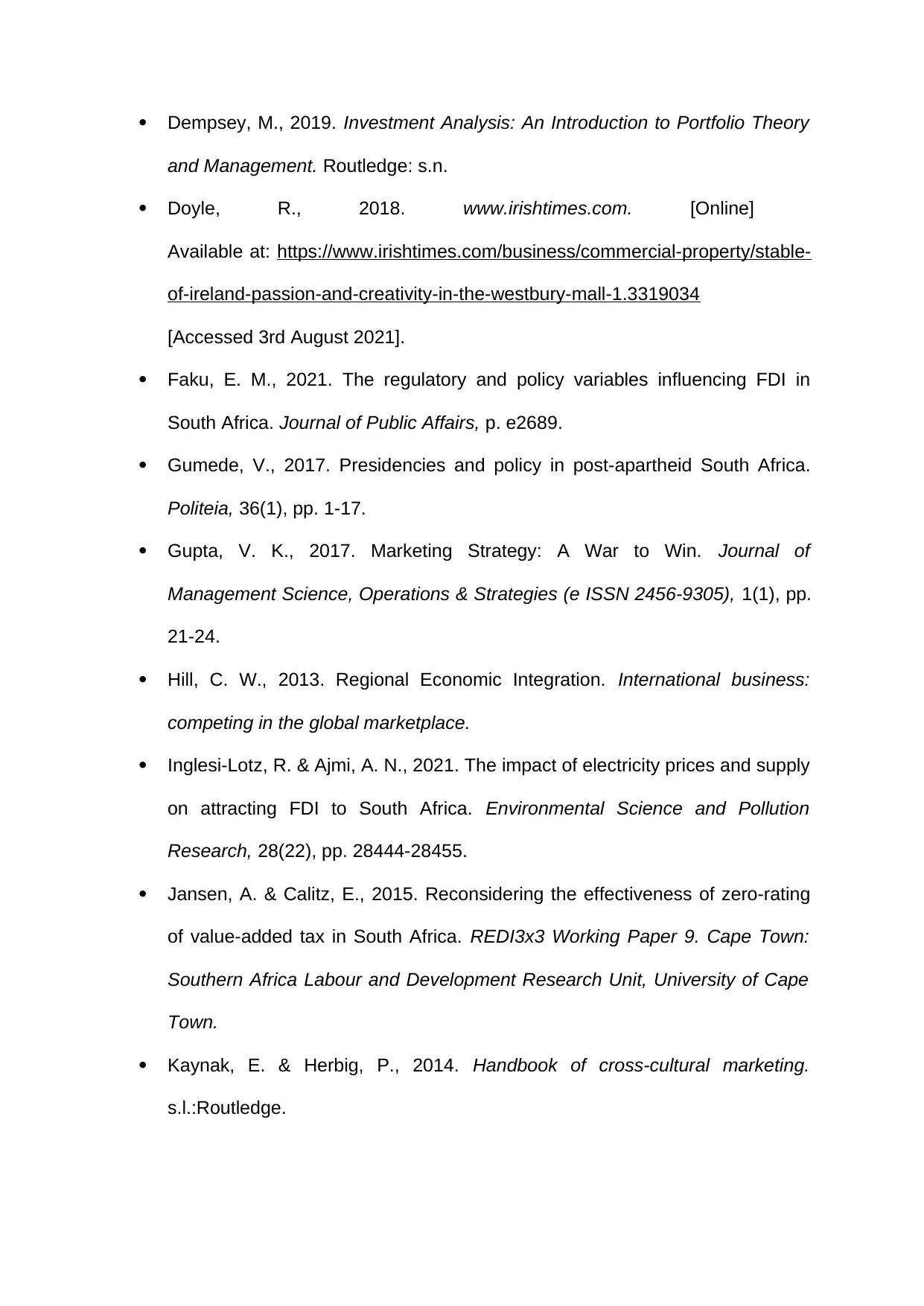
Dempsey, M., 2019. Investment Analysis: An Introduction to Portfolio Theory
and Management. Routledge: s.n.
Doyle, R., 2018. www.irishtimes.com. [Online]
Available at: https://www.irishtimes.com/business/commercial-property/stable-
of-ireland-passion-and-creativity-in-the-westbury-mall-1.3319034
[Accessed 3rd August 2021].
Faku, E. M., 2021. The regulatory and policy variables influencing FDI in
South Africa. Journal of Public Affairs, p. e2689.
Gumede, V., 2017. Presidencies and policy in post-apartheid South Africa.
Politeia, 36(1), pp. 1-17.
Gupta, V. K., 2017. Marketing Strategy: A War to Win. Journal of
Management Science, Operations & Strategies (e ISSN 2456-9305), 1(1), pp.
21-24.
Hill, C. W., 2013. Regional Economic Integration. International business:
competing in the global marketplace.
Inglesi-Lotz, R. & Ajmi, A. N., 2021. The impact of electricity prices and supply
on attracting FDI to South Africa. Environmental Science and Pollution
Research, 28(22), pp. 28444-28455.
Jansen, A. & Calitz, E., 2015. Reconsidering the effectiveness of zero-rating
of value-added tax in South Africa. REDI3x3 Working Paper 9. Cape Town:
Southern Africa Labour and Development Research Unit, University of Cape
Town.
Kaynak, E. & Herbig, P., 2014. Handbook of cross-cultural marketing.
s.l.:Routledge.
and Management. Routledge: s.n.
Doyle, R., 2018. www.irishtimes.com. [Online]
Available at: https://www.irishtimes.com/business/commercial-property/stable-
of-ireland-passion-and-creativity-in-the-westbury-mall-1.3319034
[Accessed 3rd August 2021].
Faku, E. M., 2021. The regulatory and policy variables influencing FDI in
South Africa. Journal of Public Affairs, p. e2689.
Gumede, V., 2017. Presidencies and policy in post-apartheid South Africa.
Politeia, 36(1), pp. 1-17.
Gupta, V. K., 2017. Marketing Strategy: A War to Win. Journal of
Management Science, Operations & Strategies (e ISSN 2456-9305), 1(1), pp.
21-24.
Hill, C. W., 2013. Regional Economic Integration. International business:
competing in the global marketplace.
Inglesi-Lotz, R. & Ajmi, A. N., 2021. The impact of electricity prices and supply
on attracting FDI to South Africa. Environmental Science and Pollution
Research, 28(22), pp. 28444-28455.
Jansen, A. & Calitz, E., 2015. Reconsidering the effectiveness of zero-rating
of value-added tax in South Africa. REDI3x3 Working Paper 9. Cape Town:
Southern Africa Labour and Development Research Unit, University of Cape
Town.
Kaynak, E. & Herbig, P., 2014. Handbook of cross-cultural marketing.
s.l.:Routledge.

Kionka, R., 2021. www.businesslive.co.za. [Online]
Available at: https://www.businesslive.co.za/bd/opinion/2021-02-22-
opportunities-abound-for-sa-textile-sector/
[Accessed 2nd August 2021].
Knecht, M., 2013. Diversification, industry dynamism, and economic
performance: The impact of dynamic-related diversification on the multi-
business firm. s.l.: Springer Science & Business Media.
Le Guern, S., 2020. https://twyg.co.za/study-reveals-real-value-of-south-
african-fashion-designers-be-pleasantly-surprised/. [Online]
Available at: https://twyg.co.za/study-reveals-real-value-of-south-african-
fashion-designers-be-pleasantly-surprised/
[Accessed 19 August 2021].
Lemon, A., 2021. The apartheid city. In: In South African Urban Change
Three Decades After Apartheid. s.l.:Springer, Cham, pp. 1-16.
Leonidou, L. C., Katsikeas, C. S., Palihawadana, D. & Spyropoulou, S., 2007.
An analytical review of the factors stimulating smaller firms to export:
Implications for policy‐makers. International Marketing Review.
Lombard, M., 2021. Parol evidence and the Consumer Protection Act 68 of
2008. Potchefstroom Electronic Law Journal, Volume 24, pp. 1-27.
Madanoglu, M., Alon, I. & Shoham, A., 2017. Push and pull factors in
international franchising. International Marketing Review.
Mathur, S., 2017. Glocalization in Fast Food Chains Glocalization in Fast
Food Chains: A Case Study of McDonald's. In Strategic Marketing
Management and Tactics in the Service Industry, pp. 330-347.
Available at: https://www.businesslive.co.za/bd/opinion/2021-02-22-
opportunities-abound-for-sa-textile-sector/
[Accessed 2nd August 2021].
Knecht, M., 2013. Diversification, industry dynamism, and economic
performance: The impact of dynamic-related diversification on the multi-
business firm. s.l.: Springer Science & Business Media.
Le Guern, S., 2020. https://twyg.co.za/study-reveals-real-value-of-south-
african-fashion-designers-be-pleasantly-surprised/. [Online]
Available at: https://twyg.co.za/study-reveals-real-value-of-south-african-
fashion-designers-be-pleasantly-surprised/
[Accessed 19 August 2021].
Lemon, A., 2021. The apartheid city. In: In South African Urban Change
Three Decades After Apartheid. s.l.:Springer, Cham, pp. 1-16.
Leonidou, L. C., Katsikeas, C. S., Palihawadana, D. & Spyropoulou, S., 2007.
An analytical review of the factors stimulating smaller firms to export:
Implications for policy‐makers. International Marketing Review.
Lombard, M., 2021. Parol evidence and the Consumer Protection Act 68 of
2008. Potchefstroom Electronic Law Journal, Volume 24, pp. 1-27.
Madanoglu, M., Alon, I. & Shoham, A., 2017. Push and pull factors in
international franchising. International Marketing Review.
Mathur, S., 2017. Glocalization in Fast Food Chains Glocalization in Fast
Food Chains: A Case Study of McDonald's. In Strategic Marketing
Management and Tactics in the Service Industry, pp. 330-347.
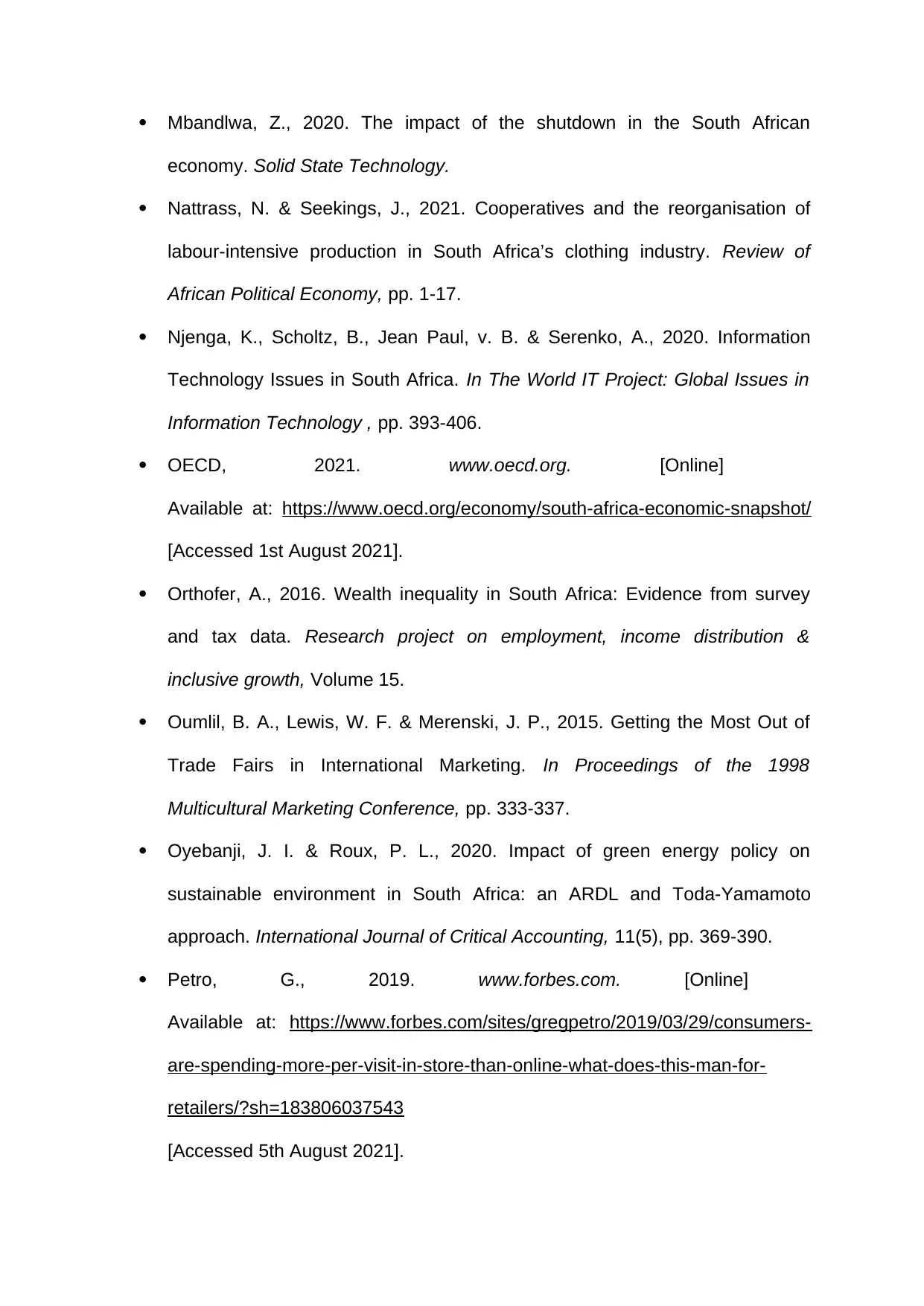
Mbandlwa, Z., 2020. The impact of the shutdown in the South African
economy. Solid State Technology.
Nattrass, N. & Seekings, J., 2021. Cooperatives and the reorganisation of
labour-intensive production in South Africa’s clothing industry. Review of
African Political Economy, pp. 1-17.
Njenga, K., Scholtz, B., Jean Paul, v. B. & Serenko, A., 2020. Information
Technology Issues in South Africa. In The World IT Project: Global Issues in
Information Technology , pp. 393-406.
OECD, 2021. www.oecd.org. [Online]
Available at: https://www.oecd.org/economy/south-africa-economic-snapshot/
[Accessed 1st August 2021].
Orthofer, A., 2016. Wealth inequality in South Africa: Evidence from survey
and tax data. Research project on employment, income distribution &
inclusive growth, Volume 15.
Oumlil, B. A., Lewis, W. F. & Merenski, J. P., 2015. Getting the Most Out of
Trade Fairs in International Marketing. In Proceedings of the 1998
Multicultural Marketing Conference, pp. 333-337.
Oyebanji, J. I. & Roux, P. L., 2020. Impact of green energy policy on
sustainable environment in South Africa: an ARDL and Toda-Yamamoto
approach. International Journal of Critical Accounting, 11(5), pp. 369-390.
Petro, G., 2019. www.forbes.com. [Online]
Available at: https://www.forbes.com/sites/gregpetro/2019/03/29/consumers-
are-spending-more-per-visit-in-store-than-online-what-does-this-man-for-
retailers/?sh=183806037543
[Accessed 5th August 2021].
economy. Solid State Technology.
Nattrass, N. & Seekings, J., 2021. Cooperatives and the reorganisation of
labour-intensive production in South Africa’s clothing industry. Review of
African Political Economy, pp. 1-17.
Njenga, K., Scholtz, B., Jean Paul, v. B. & Serenko, A., 2020. Information
Technology Issues in South Africa. In The World IT Project: Global Issues in
Information Technology , pp. 393-406.
OECD, 2021. www.oecd.org. [Online]
Available at: https://www.oecd.org/economy/south-africa-economic-snapshot/
[Accessed 1st August 2021].
Orthofer, A., 2016. Wealth inequality in South Africa: Evidence from survey
and tax data. Research project on employment, income distribution &
inclusive growth, Volume 15.
Oumlil, B. A., Lewis, W. F. & Merenski, J. P., 2015. Getting the Most Out of
Trade Fairs in International Marketing. In Proceedings of the 1998
Multicultural Marketing Conference, pp. 333-337.
Oyebanji, J. I. & Roux, P. L., 2020. Impact of green energy policy on
sustainable environment in South Africa: an ARDL and Toda-Yamamoto
approach. International Journal of Critical Accounting, 11(5), pp. 369-390.
Petro, G., 2019. www.forbes.com. [Online]
Available at: https://www.forbes.com/sites/gregpetro/2019/03/29/consumers-
are-spending-more-per-visit-in-store-than-online-what-does-this-man-for-
retailers/?sh=183806037543
[Accessed 5th August 2021].
Secure Best Marks with AI Grader
Need help grading? Try our AI Grader for instant feedback on your assignments.
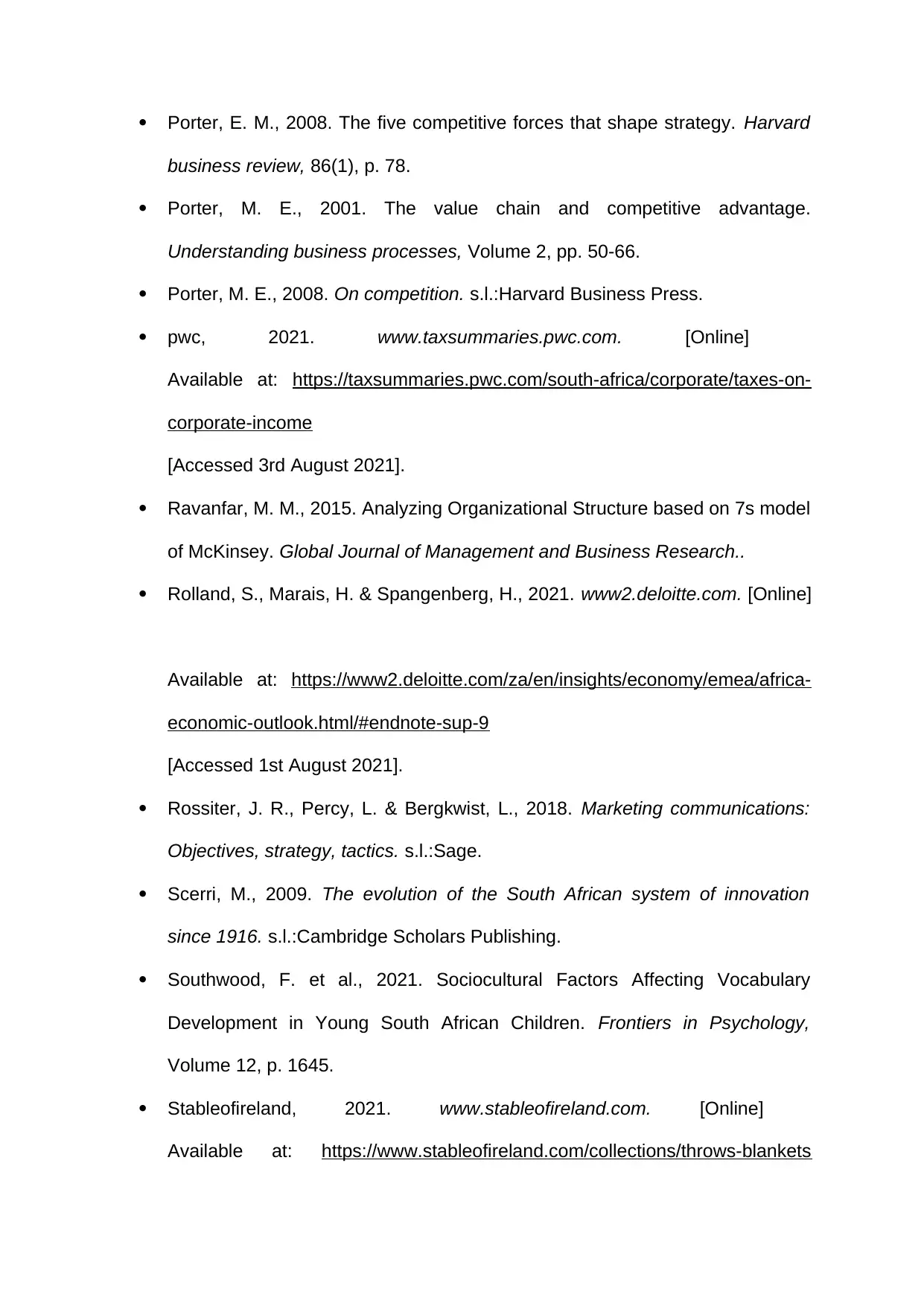
Porter, E. M., 2008. The five competitive forces that shape strategy. Harvard
business review, 86(1), p. 78.
Porter, M. E., 2001. The value chain and competitive advantage.
Understanding business processes, Volume 2, pp. 50-66.
Porter, M. E., 2008. On competition. s.l.:Harvard Business Press.
pwc, 2021. www.taxsummaries.pwc.com. [Online]
Available at: https://taxsummaries.pwc.com/south-africa/corporate/taxes-on-
corporate-income
[Accessed 3rd August 2021].
Ravanfar, M. M., 2015. Analyzing Organizational Structure based on 7s model
of McKinsey. Global Journal of Management and Business Research..
Rolland, S., Marais, H. & Spangenberg, H., 2021. www2.deloitte.com. [Online]
Available at: https://www2.deloitte.com/za/en/insights/economy/emea/africa-
economic-outlook.html/#endnote-sup-9
[Accessed 1st August 2021].
Rossiter, J. R., Percy, L. & Bergkwist, L., 2018. Marketing communications:
Objectives, strategy, tactics. s.l.:Sage.
Scerri, M., 2009. The evolution of the South African system of innovation
since 1916. s.l.:Cambridge Scholars Publishing.
Southwood, F. et al., 2021. Sociocultural Factors Affecting Vocabulary
Development in Young South African Children. Frontiers in Psychology,
Volume 12, p. 1645.
Stableofireland, 2021. www.stableofireland.com. [Online]
Available at: https://www.stableofireland.com/collections/throws-blankets
business review, 86(1), p. 78.
Porter, M. E., 2001. The value chain and competitive advantage.
Understanding business processes, Volume 2, pp. 50-66.
Porter, M. E., 2008. On competition. s.l.:Harvard Business Press.
pwc, 2021. www.taxsummaries.pwc.com. [Online]
Available at: https://taxsummaries.pwc.com/south-africa/corporate/taxes-on-
corporate-income
[Accessed 3rd August 2021].
Ravanfar, M. M., 2015. Analyzing Organizational Structure based on 7s model
of McKinsey. Global Journal of Management and Business Research..
Rolland, S., Marais, H. & Spangenberg, H., 2021. www2.deloitte.com. [Online]
Available at: https://www2.deloitte.com/za/en/insights/economy/emea/africa-
economic-outlook.html/#endnote-sup-9
[Accessed 1st August 2021].
Rossiter, J. R., Percy, L. & Bergkwist, L., 2018. Marketing communications:
Objectives, strategy, tactics. s.l.:Sage.
Scerri, M., 2009. The evolution of the South African system of innovation
since 1916. s.l.:Cambridge Scholars Publishing.
Southwood, F. et al., 2021. Sociocultural Factors Affecting Vocabulary
Development in Young South African Children. Frontiers in Psychology,
Volume 12, p. 1645.
Stableofireland, 2021. www.stableofireland.com. [Online]
Available at: https://www.stableofireland.com/collections/throws-blankets
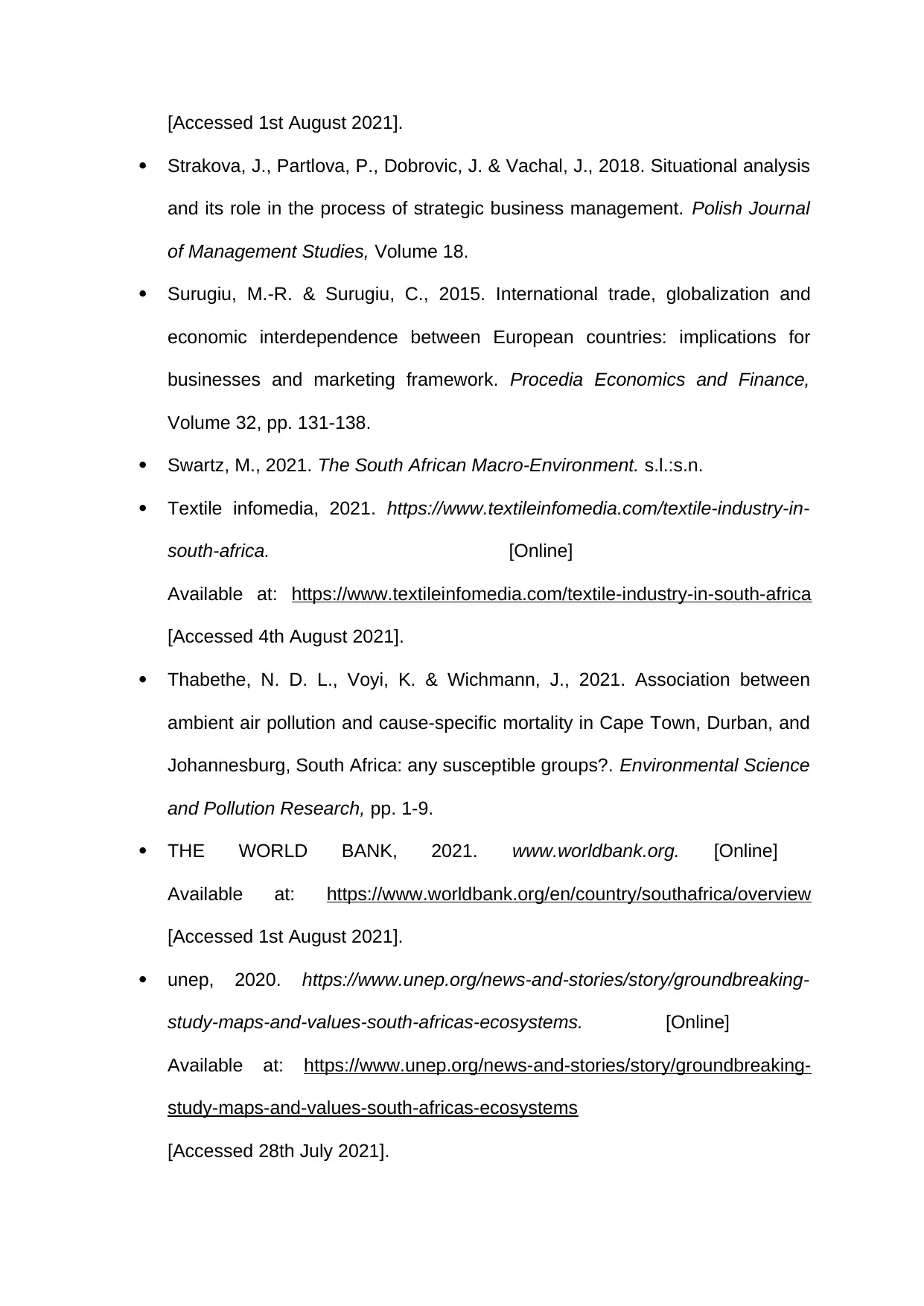
[Accessed 1st August 2021].
Strakova, J., Partlova, P., Dobrovic, J. & Vachal, J., 2018. Situational analysis
and its role in the process of strategic business management. Polish Journal
of Management Studies, Volume 18.
Surugiu, M.-R. & Surugiu, C., 2015. International trade, globalization and
economic interdependence between European countries: implications for
businesses and marketing framework. Procedia Economics and Finance,
Volume 32, pp. 131-138.
Swartz, M., 2021. The South African Macro-Environment. s.l.:s.n.
Textile infomedia, 2021. https://www.textileinfomedia.com/textile-industry-in-
south-africa. [Online]
Available at: https://www.textileinfomedia.com/textile-industry-in-south-africa
[Accessed 4th August 2021].
Thabethe, N. D. L., Voyi, K. & Wichmann, J., 2021. Association between
ambient air pollution and cause-specific mortality in Cape Town, Durban, and
Johannesburg, South Africa: any susceptible groups?. Environmental Science
and Pollution Research, pp. 1-9.
THE WORLD BANK, 2021. www.worldbank.org. [Online]
Available at: https://www.worldbank.org/en/country/southafrica/overview
[Accessed 1st August 2021].
unep, 2020. https://www.unep.org/news-and-stories/story/groundbreaking-
study-maps-and-values-south-africas-ecosystems. [Online]
Available at: https://www.unep.org/news-and-stories/story/groundbreaking-
study-maps-and-values-south-africas-ecosystems
[Accessed 28th July 2021].
Strakova, J., Partlova, P., Dobrovic, J. & Vachal, J., 2018. Situational analysis
and its role in the process of strategic business management. Polish Journal
of Management Studies, Volume 18.
Surugiu, M.-R. & Surugiu, C., 2015. International trade, globalization and
economic interdependence between European countries: implications for
businesses and marketing framework. Procedia Economics and Finance,
Volume 32, pp. 131-138.
Swartz, M., 2021. The South African Macro-Environment. s.l.:s.n.
Textile infomedia, 2021. https://www.textileinfomedia.com/textile-industry-in-
south-africa. [Online]
Available at: https://www.textileinfomedia.com/textile-industry-in-south-africa
[Accessed 4th August 2021].
Thabethe, N. D. L., Voyi, K. & Wichmann, J., 2021. Association between
ambient air pollution and cause-specific mortality in Cape Town, Durban, and
Johannesburg, South Africa: any susceptible groups?. Environmental Science
and Pollution Research, pp. 1-9.
THE WORLD BANK, 2021. www.worldbank.org. [Online]
Available at: https://www.worldbank.org/en/country/southafrica/overview
[Accessed 1st August 2021].
unep, 2020. https://www.unep.org/news-and-stories/story/groundbreaking-
study-maps-and-values-south-africas-ecosystems. [Online]
Available at: https://www.unep.org/news-and-stories/story/groundbreaking-
study-maps-and-values-south-africas-ecosystems
[Accessed 28th July 2021].
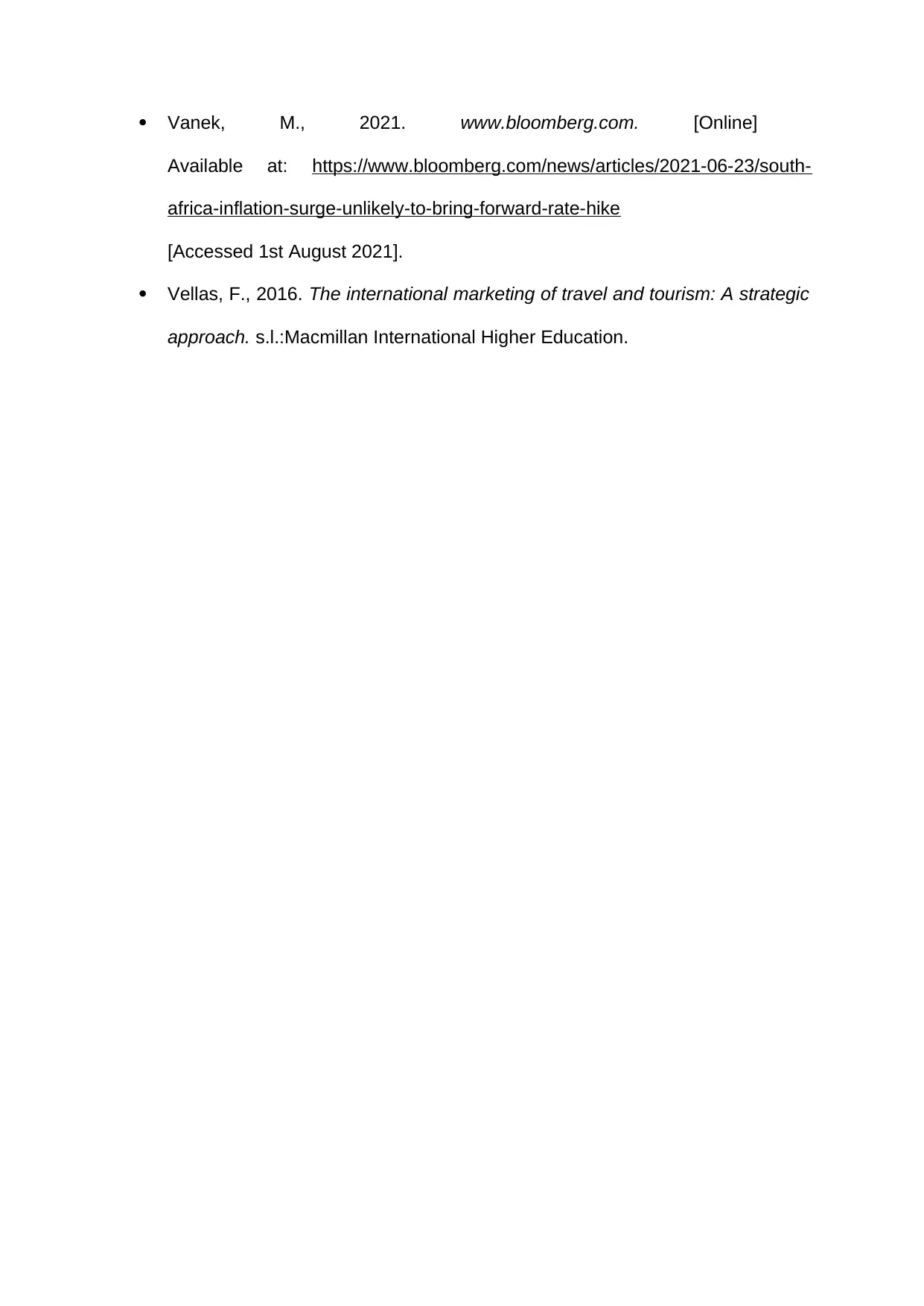
Vanek, M., 2021. www.bloomberg.com. [Online]
Available at: https://www.bloomberg.com/news/articles/2021-06-23/south-
africa-inflation-surge-unlikely-to-bring-forward-rate-hike
[Accessed 1st August 2021].
Vellas, F., 2016. The international marketing of travel and tourism: A strategic
approach. s.l.:Macmillan International Higher Education.
Available at: https://www.bloomberg.com/news/articles/2021-06-23/south-
africa-inflation-surge-unlikely-to-bring-forward-rate-hike
[Accessed 1st August 2021].
Vellas, F., 2016. The international marketing of travel and tourism: A strategic
approach. s.l.:Macmillan International Higher Education.
Paraphrase This Document
Need a fresh take? Get an instant paraphrase of this document with our AI Paraphraser
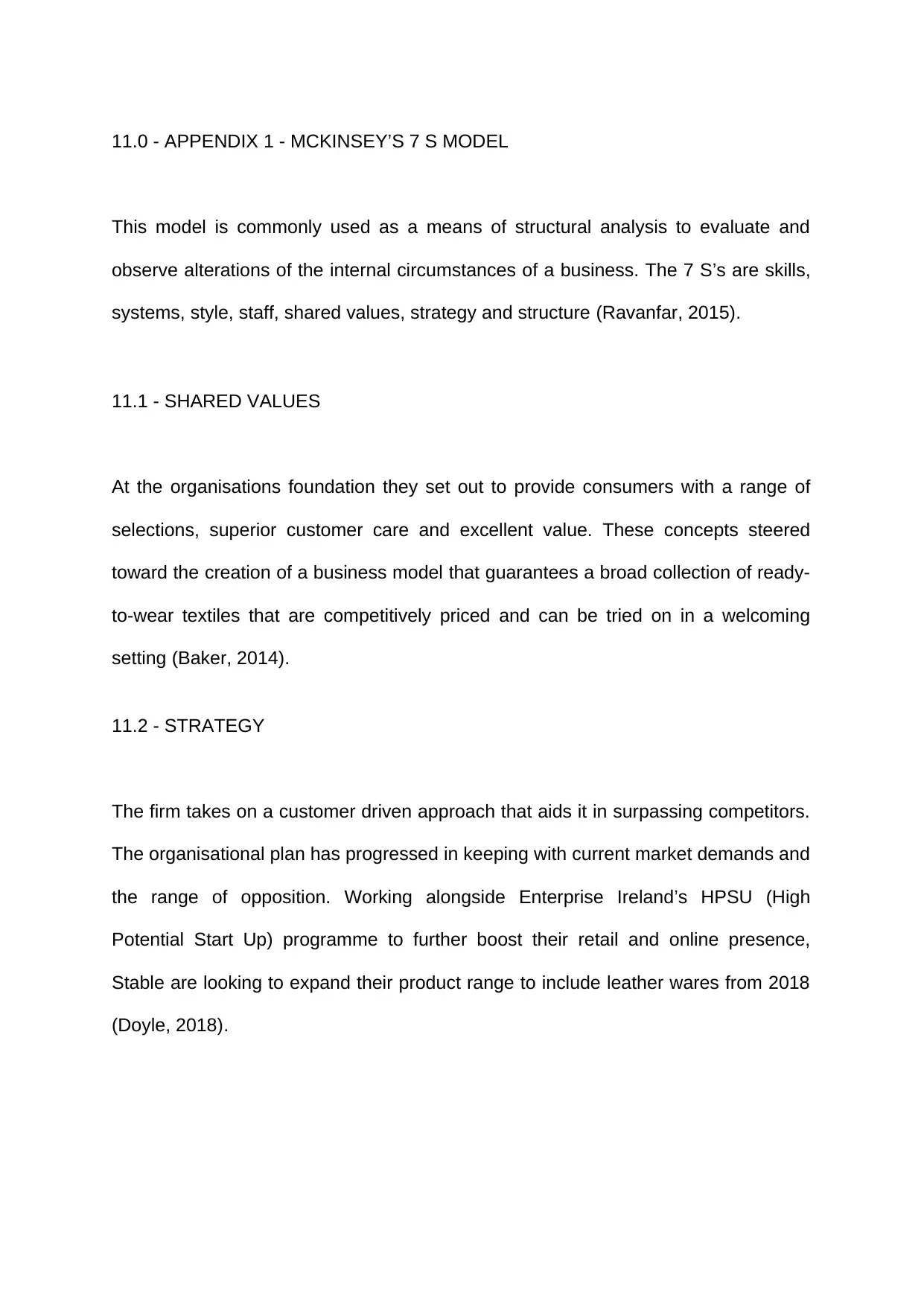
11.0 - APPENDIX 1 - MCKINSEY’S 7 S MODEL
This model is commonly used as a means of structural analysis to evaluate and
observe alterations of the internal circumstances of a business. The 7 S’s are skills,
systems, style, staff, shared values, strategy and structure (Ravanfar, 2015).
11.1 - SHARED VALUES
At the organisations foundation they set out to provide consumers with a range of
selections, superior customer care and excellent value. These concepts steered
toward the creation of a business model that guarantees a broad collection of ready-
to-wear textiles that are competitively priced and can be tried on in a welcoming
setting (Baker, 2014).
11.2 - STRATEGY
The firm takes on a customer driven approach that aids it in surpassing competitors.
The organisational plan has progressed in keeping with current market demands and
the range of opposition. Working alongside Enterprise Ireland’s HPSU (High
Potential Start Up) programme to further boost their retail and online presence,
Stable are looking to expand their product range to include leather wares from 2018
(Doyle, 2018).
This model is commonly used as a means of structural analysis to evaluate and
observe alterations of the internal circumstances of a business. The 7 S’s are skills,
systems, style, staff, shared values, strategy and structure (Ravanfar, 2015).
11.1 - SHARED VALUES
At the organisations foundation they set out to provide consumers with a range of
selections, superior customer care and excellent value. These concepts steered
toward the creation of a business model that guarantees a broad collection of ready-
to-wear textiles that are competitively priced and can be tried on in a welcoming
setting (Baker, 2014).
11.2 - STRATEGY
The firm takes on a customer driven approach that aids it in surpassing competitors.
The organisational plan has progressed in keeping with current market demands and
the range of opposition. Working alongside Enterprise Ireland’s HPSU (High
Potential Start Up) programme to further boost their retail and online presence,
Stable are looking to expand their product range to include leather wares from 2018
(Doyle, 2018).
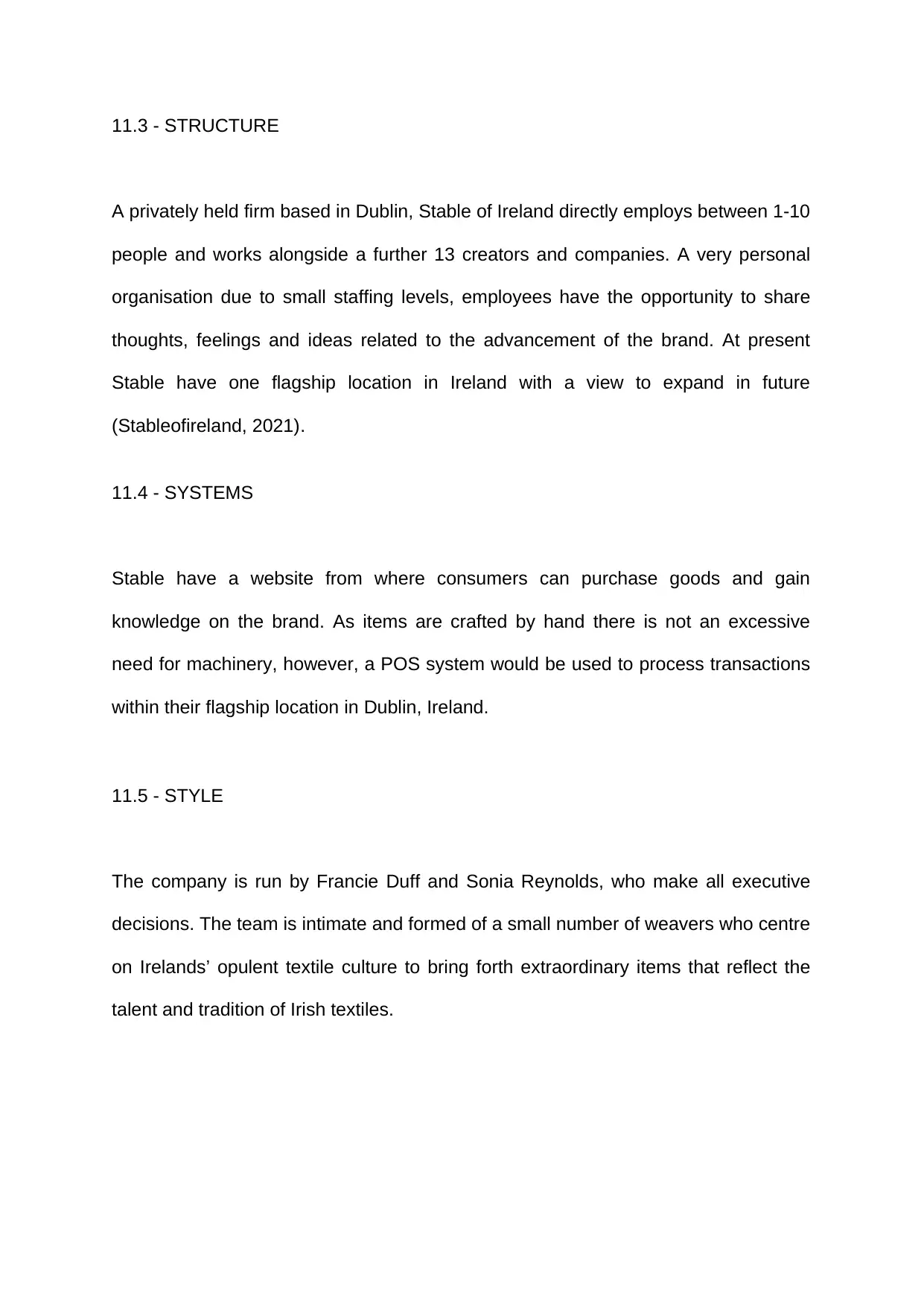
11.3 - STRUCTURE
A privately held firm based in Dublin, Stable of Ireland directly employs between 1-10
people and works alongside a further 13 creators and companies. A very personal
organisation due to small staffing levels, employees have the opportunity to share
thoughts, feelings and ideas related to the advancement of the brand. At present
Stable have one flagship location in Ireland with a view to expand in future
(Stableofireland, 2021).
11.4 - SYSTEMS
Stable have a website from where consumers can purchase goods and gain
knowledge on the brand. As items are crafted by hand there is not an excessive
need for machinery, however, a POS system would be used to process transactions
within their flagship location in Dublin, Ireland.
11.5 - STYLE
The company is run by Francie Duff and Sonia Reynolds, who make all executive
decisions. The team is intimate and formed of a small number of weavers who centre
on Irelands’ opulent textile culture to bring forth extraordinary items that reflect the
talent and tradition of Irish textiles.
A privately held firm based in Dublin, Stable of Ireland directly employs between 1-10
people and works alongside a further 13 creators and companies. A very personal
organisation due to small staffing levels, employees have the opportunity to share
thoughts, feelings and ideas related to the advancement of the brand. At present
Stable have one flagship location in Ireland with a view to expand in future
(Stableofireland, 2021).
11.4 - SYSTEMS
Stable have a website from where consumers can purchase goods and gain
knowledge on the brand. As items are crafted by hand there is not an excessive
need for machinery, however, a POS system would be used to process transactions
within their flagship location in Dublin, Ireland.
11.5 - STYLE
The company is run by Francie Duff and Sonia Reynolds, who make all executive
decisions. The team is intimate and formed of a small number of weavers who centre
on Irelands’ opulent textile culture to bring forth extraordinary items that reflect the
talent and tradition of Irish textiles.
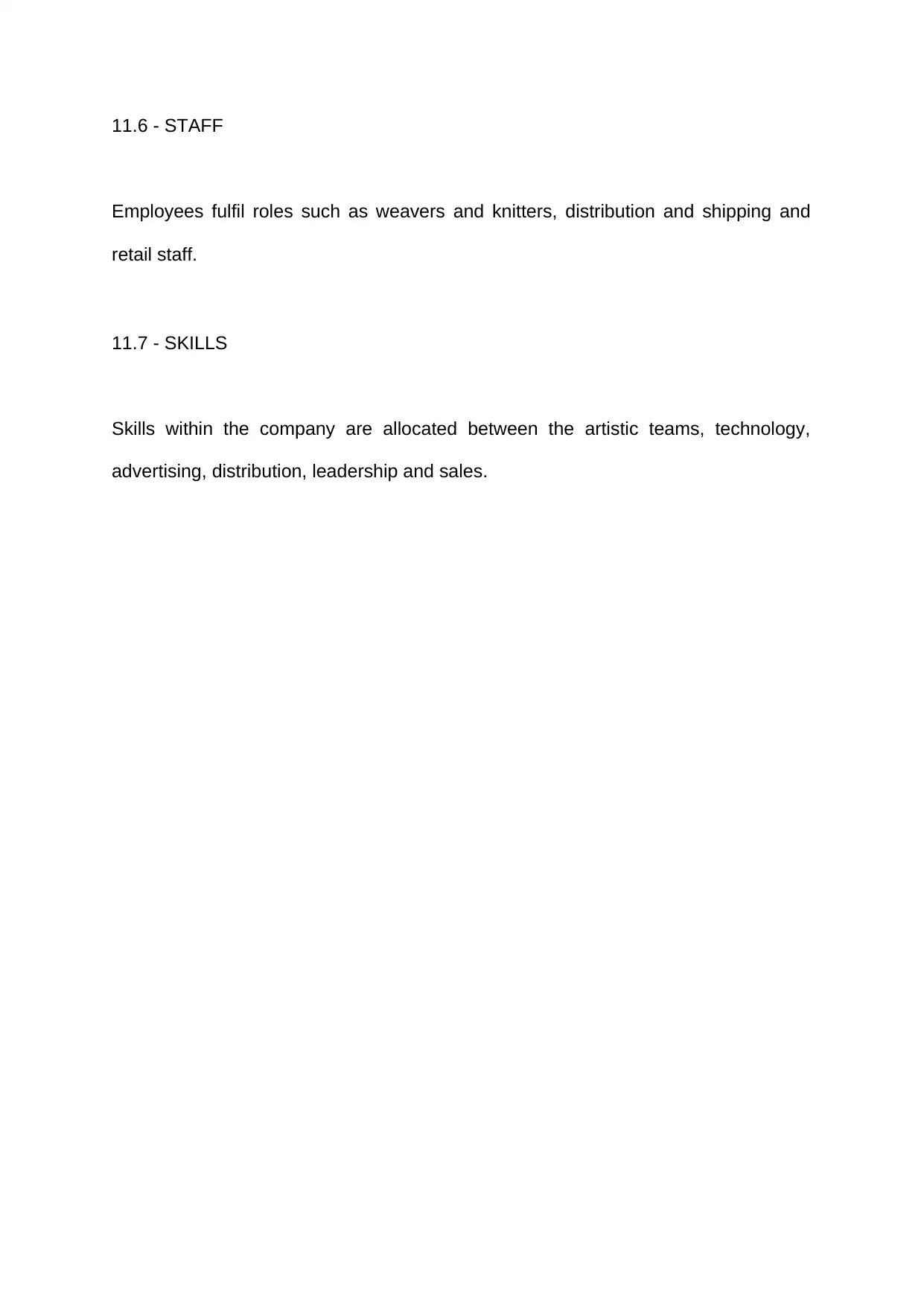
11.6 - STAFF
Employees fulfil roles such as weavers and knitters, distribution and shipping and
retail staff.
11.7 - SKILLS
Skills within the company are allocated between the artistic teams, technology,
advertising, distribution, leadership and sales.
Employees fulfil roles such as weavers and knitters, distribution and shipping and
retail staff.
11.7 - SKILLS
Skills within the company are allocated between the artistic teams, technology,
advertising, distribution, leadership and sales.
Secure Best Marks with AI Grader
Need help grading? Try our AI Grader for instant feedback on your assignments.
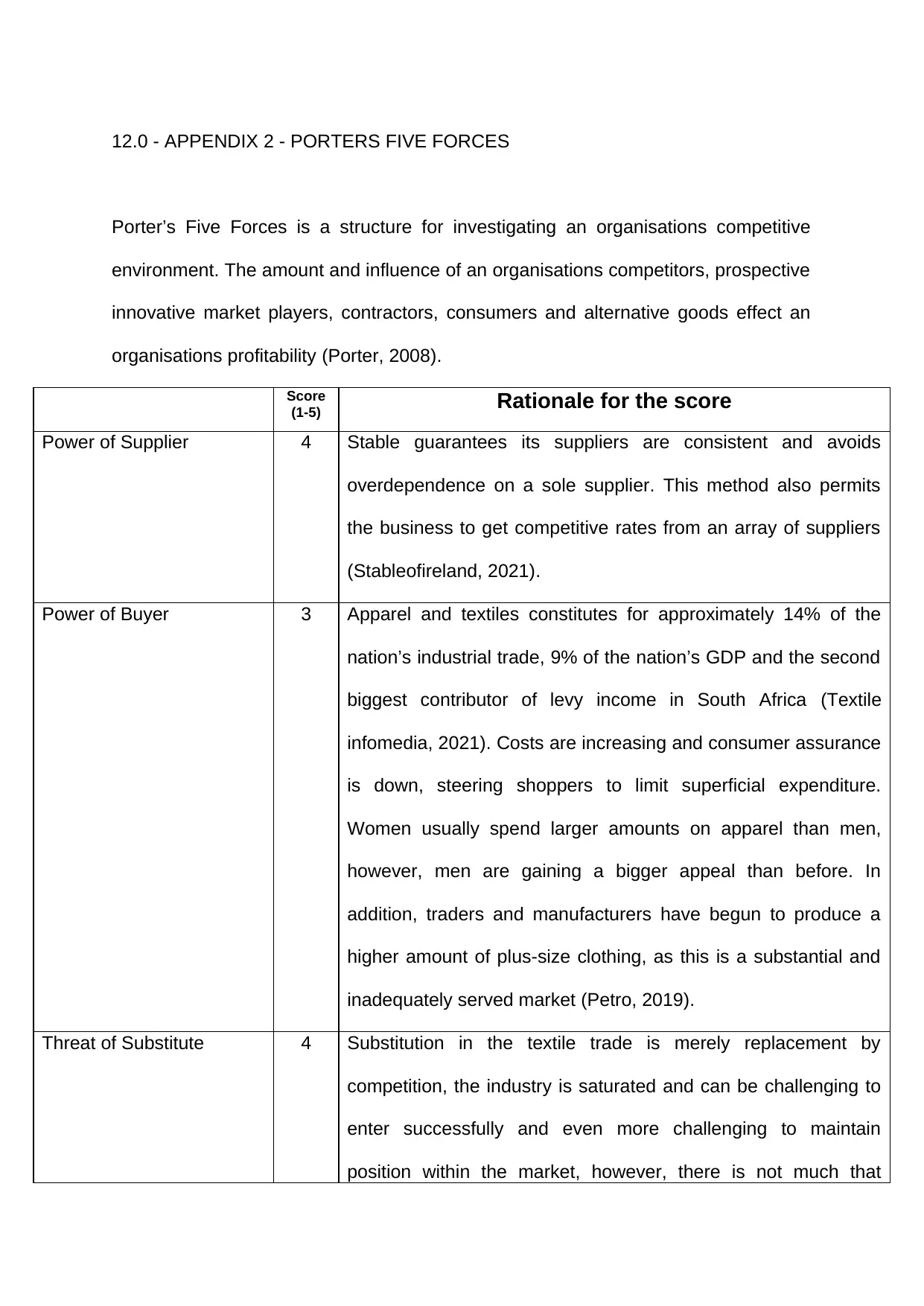
12.0 - APPENDIX 2 - PORTERS FIVE FORCES
Porter’s Five Forces is a structure for investigating an organisations competitive
environment. The amount and influence of an organisations competitors, prospective
innovative market players, contractors, consumers and alternative goods effect an
organisations profitability (Porter, 2008).
Score
(1-5) Rationale for the score
Power of Supplier 4 Stable guarantees its suppliers are consistent and avoids
overdependence on a sole supplier. This method also permits
the business to get competitive rates from an array of suppliers
(Stableofireland, 2021).
Power of Buyer 3 Apparel and textiles constitutes for approximately 14% of the
nation’s industrial trade, 9% of the nation’s GDP and the second
biggest contributor of levy income in South Africa (Textile
infomedia, 2021). Costs are increasing and consumer assurance
is down, steering shoppers to limit superficial expenditure.
Women usually spend larger amounts on apparel than men,
however, men are gaining a bigger appeal than before. In
addition, traders and manufacturers have begun to produce a
higher amount of plus-size clothing, as this is a substantial and
inadequately served market (Petro, 2019).
Threat of Substitute 4 Substitution in the textile trade is merely replacement by
competition, the industry is saturated and can be challenging to
enter successfully and even more challenging to maintain
position within the market, however, there is not much that
Porter’s Five Forces is a structure for investigating an organisations competitive
environment. The amount and influence of an organisations competitors, prospective
innovative market players, contractors, consumers and alternative goods effect an
organisations profitability (Porter, 2008).
Score
(1-5) Rationale for the score
Power of Supplier 4 Stable guarantees its suppliers are consistent and avoids
overdependence on a sole supplier. This method also permits
the business to get competitive rates from an array of suppliers
(Stableofireland, 2021).
Power of Buyer 3 Apparel and textiles constitutes for approximately 14% of the
nation’s industrial trade, 9% of the nation’s GDP and the second
biggest contributor of levy income in South Africa (Textile
infomedia, 2021). Costs are increasing and consumer assurance
is down, steering shoppers to limit superficial expenditure.
Women usually spend larger amounts on apparel than men,
however, men are gaining a bigger appeal than before. In
addition, traders and manufacturers have begun to produce a
higher amount of plus-size clothing, as this is a substantial and
inadequately served market (Petro, 2019).
Threat of Substitute 4 Substitution in the textile trade is merely replacement by
competition, the industry is saturated and can be challenging to
enter successfully and even more challenging to maintain
position within the market, however, there is not much that
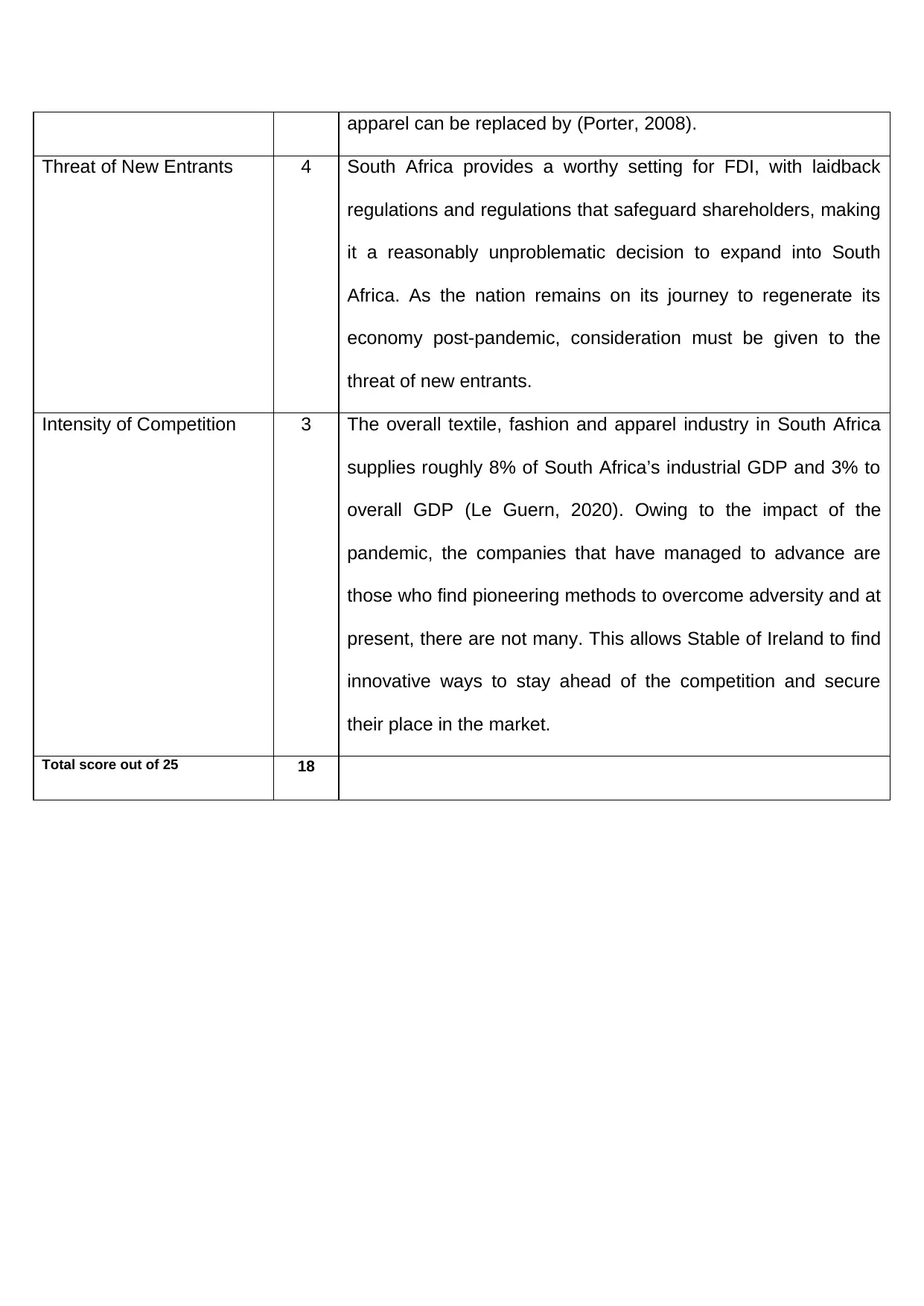
apparel can be replaced by (Porter, 2008).
Threat of New Entrants 4 South Africa provides a worthy setting for FDI, with laidback
regulations and regulations that safeguard shareholders, making
it a reasonably unproblematic decision to expand into South
Africa. As the nation remains on its journey to regenerate its
economy post-pandemic, consideration must be given to the
threat of new entrants.
Intensity of Competition 3 The overall textile, fashion and apparel industry in South Africa
supplies roughly 8% of South Africa’s industrial GDP and 3% to
overall GDP (Le Guern, 2020). Owing to the impact of the
pandemic, the companies that have managed to advance are
those who find pioneering methods to overcome adversity and at
present, there are not many. This allows Stable of Ireland to find
innovative ways to stay ahead of the competition and secure
their place in the market.
Total score out of 25 18
Threat of New Entrants 4 South Africa provides a worthy setting for FDI, with laidback
regulations and regulations that safeguard shareholders, making
it a reasonably unproblematic decision to expand into South
Africa. As the nation remains on its journey to regenerate its
economy post-pandemic, consideration must be given to the
threat of new entrants.
Intensity of Competition 3 The overall textile, fashion and apparel industry in South Africa
supplies roughly 8% of South Africa’s industrial GDP and 3% to
overall GDP (Le Guern, 2020). Owing to the impact of the
pandemic, the companies that have managed to advance are
those who find pioneering methods to overcome adversity and at
present, there are not many. This allows Stable of Ireland to find
innovative ways to stay ahead of the competition and secure
their place in the market.
Total score out of 25 18
1 out of 42
Your All-in-One AI-Powered Toolkit for Academic Success.
+13062052269
info@desklib.com
Available 24*7 on WhatsApp / Email
![[object Object]](/_next/static/media/star-bottom.7253800d.svg)
Unlock your academic potential
© 2024 | Zucol Services PVT LTD | All rights reserved.

